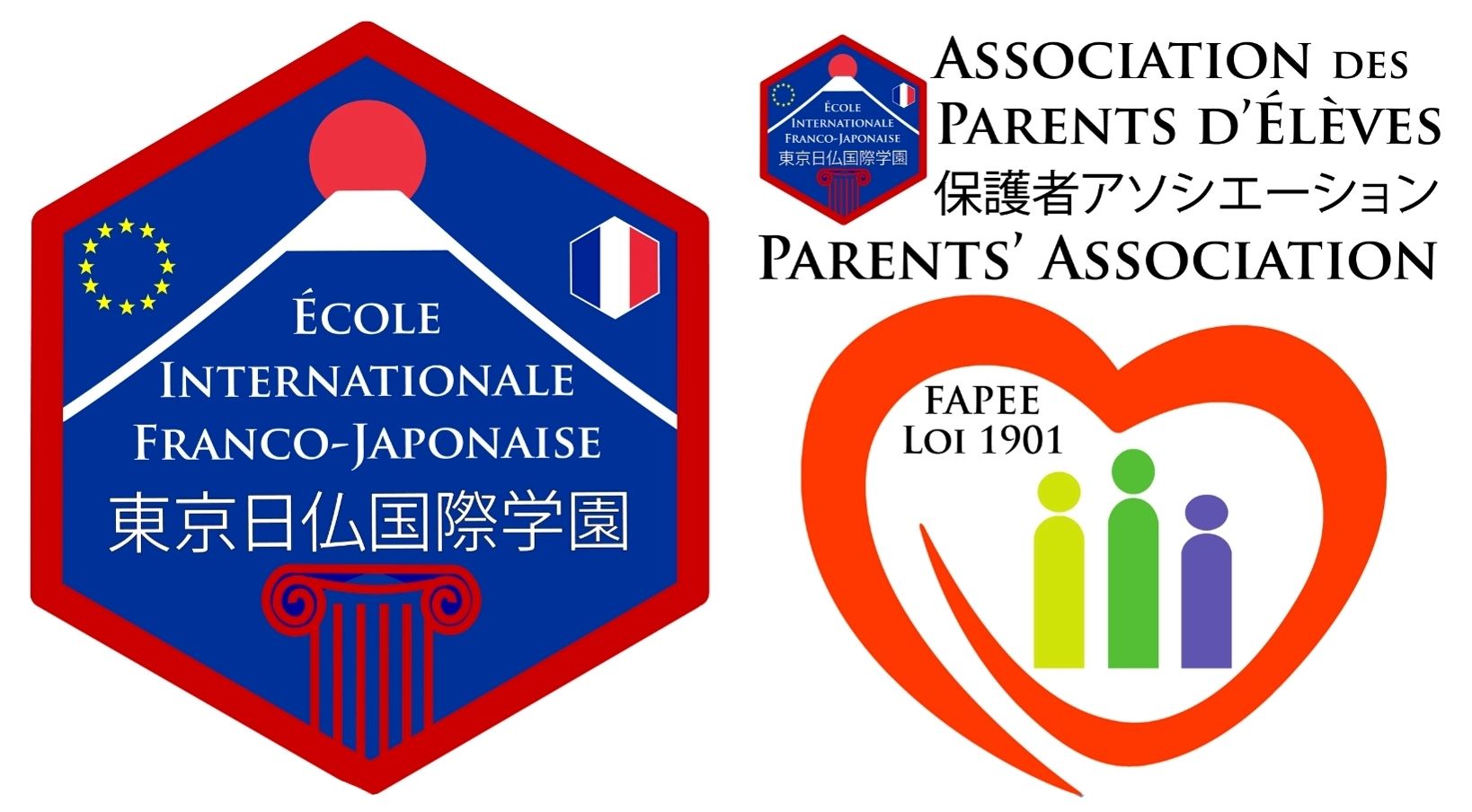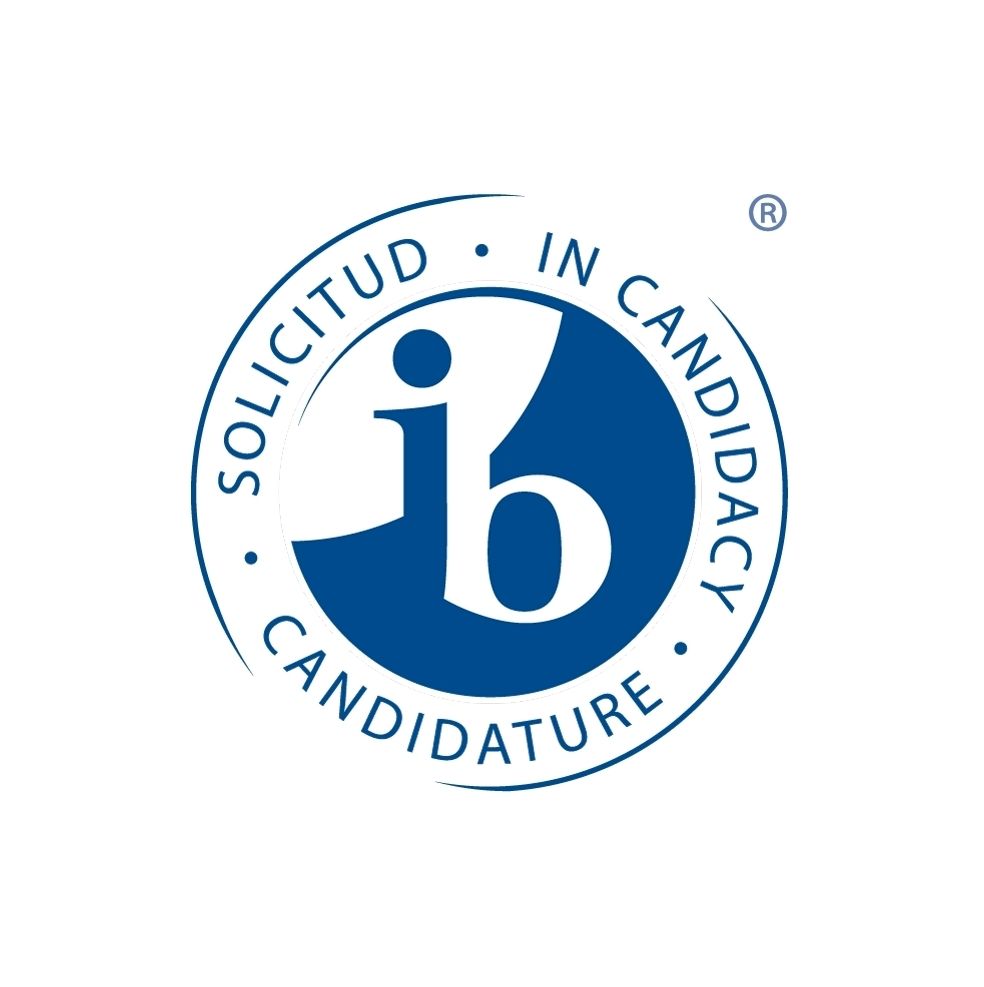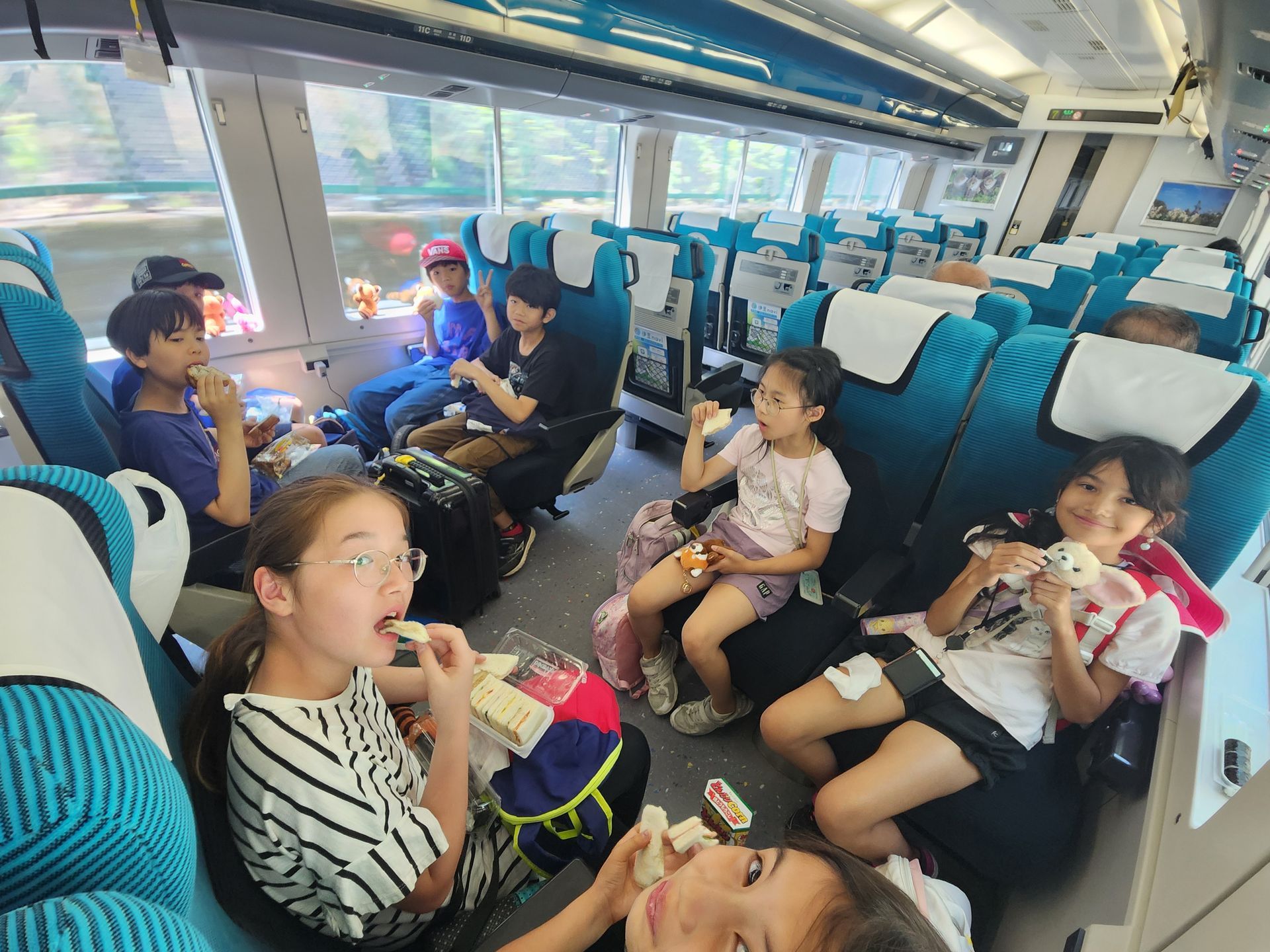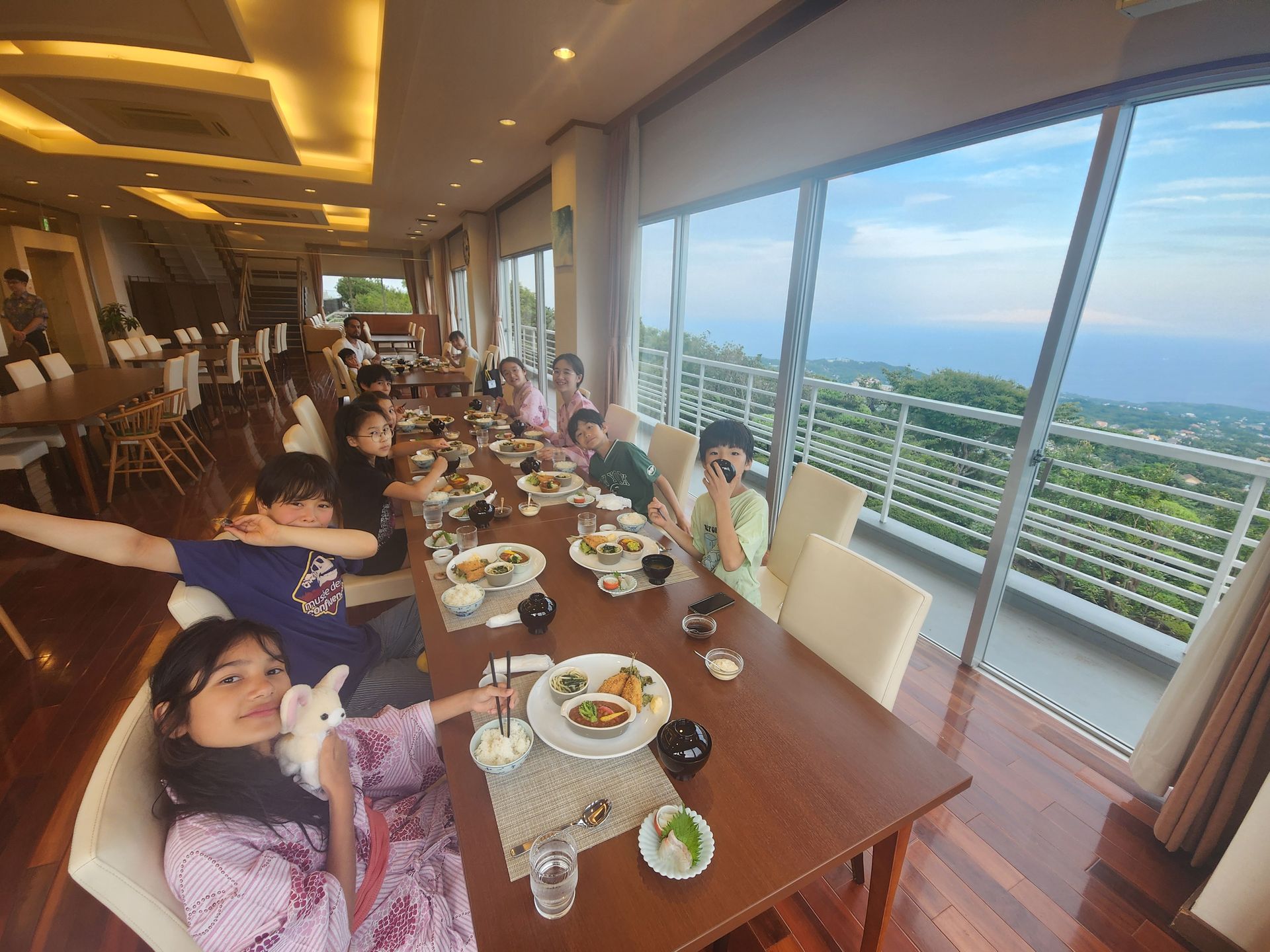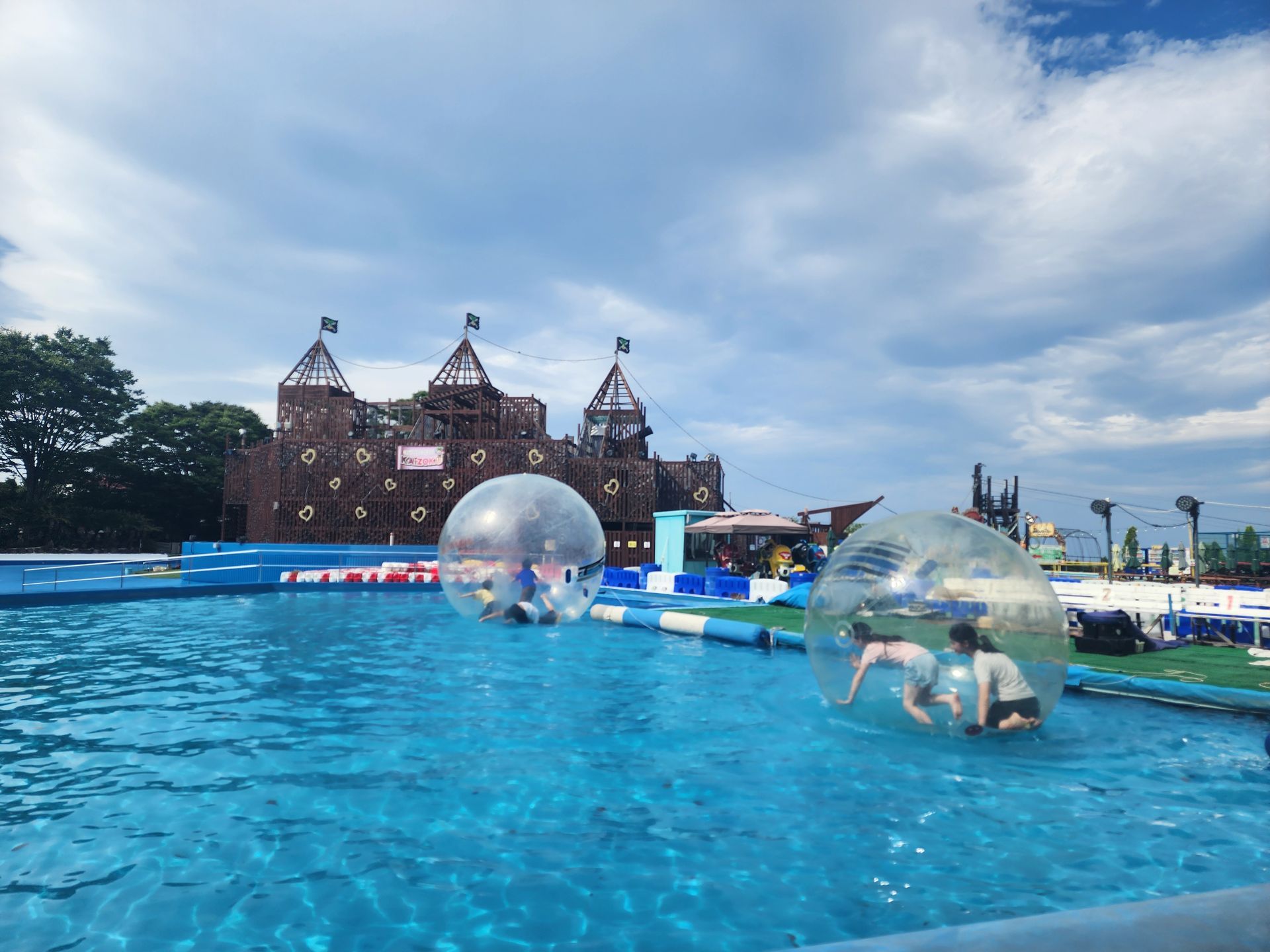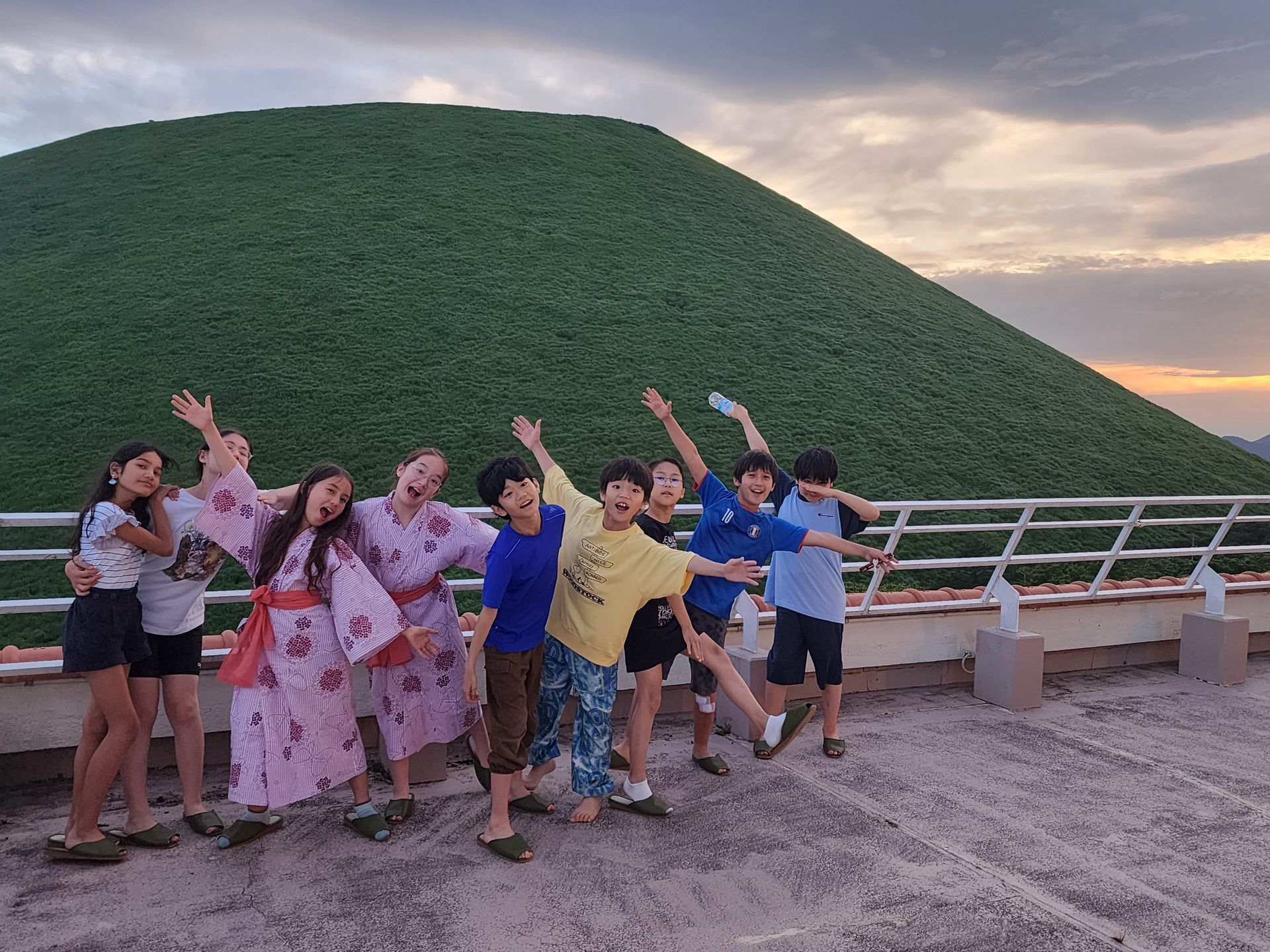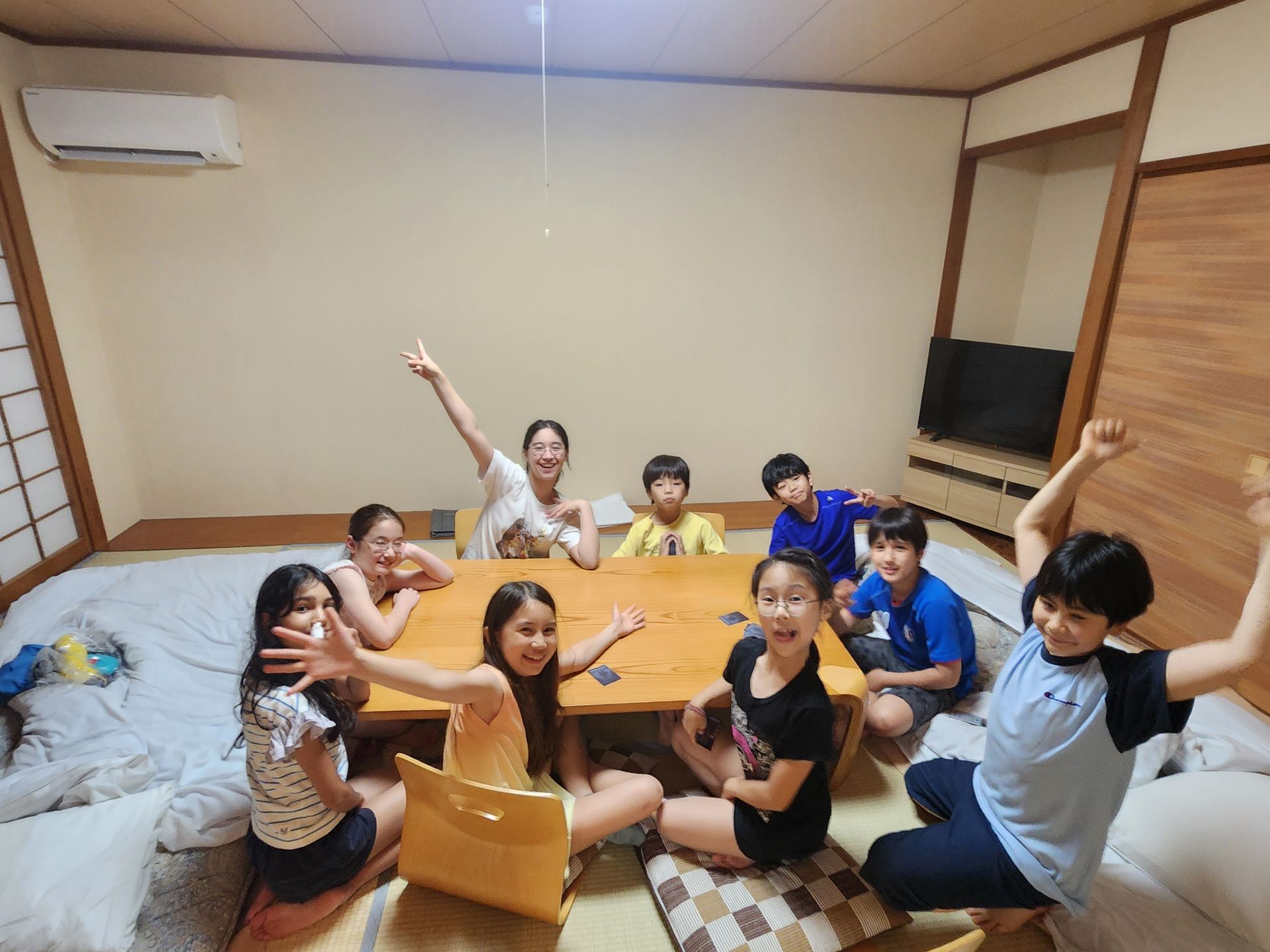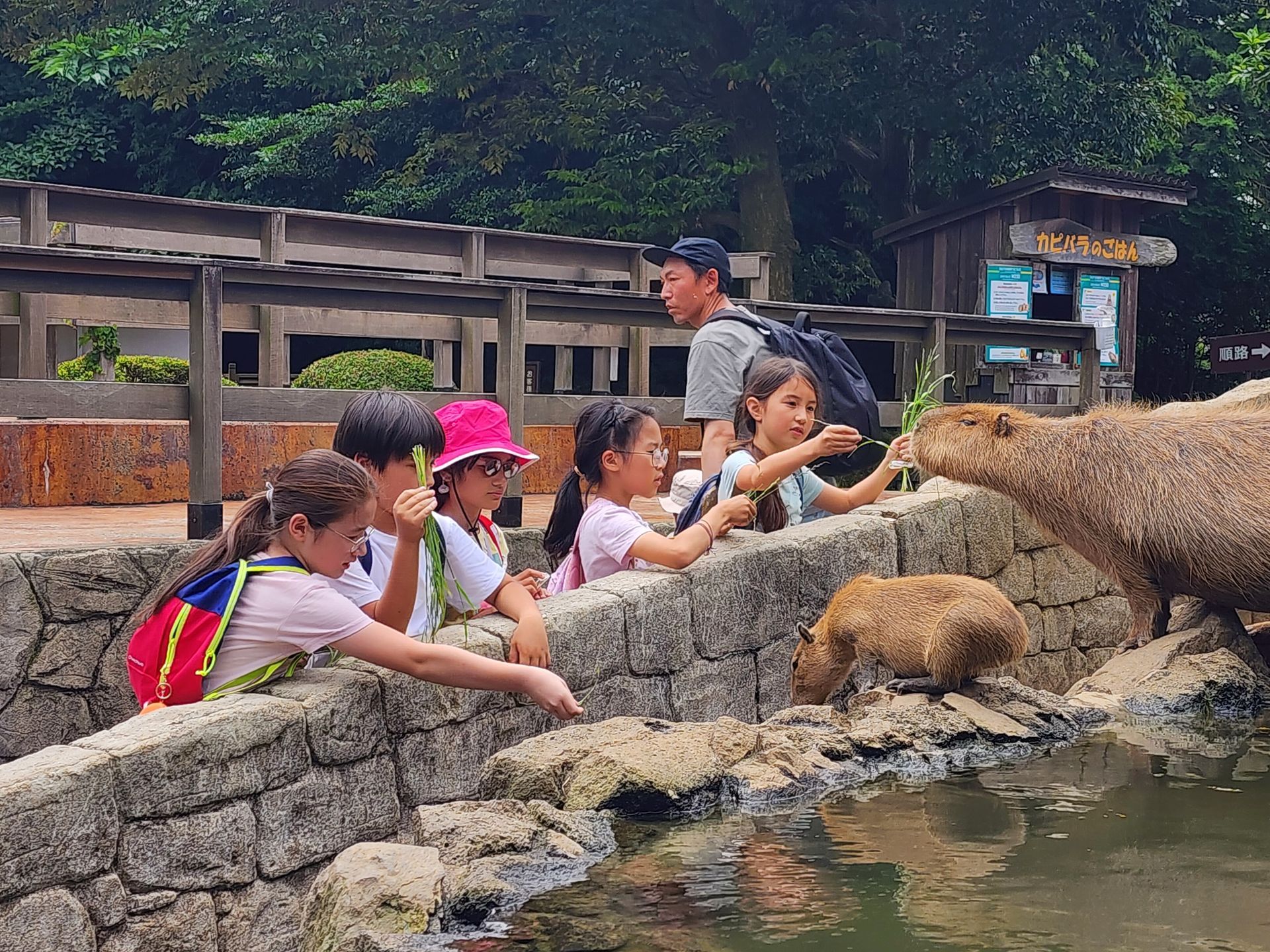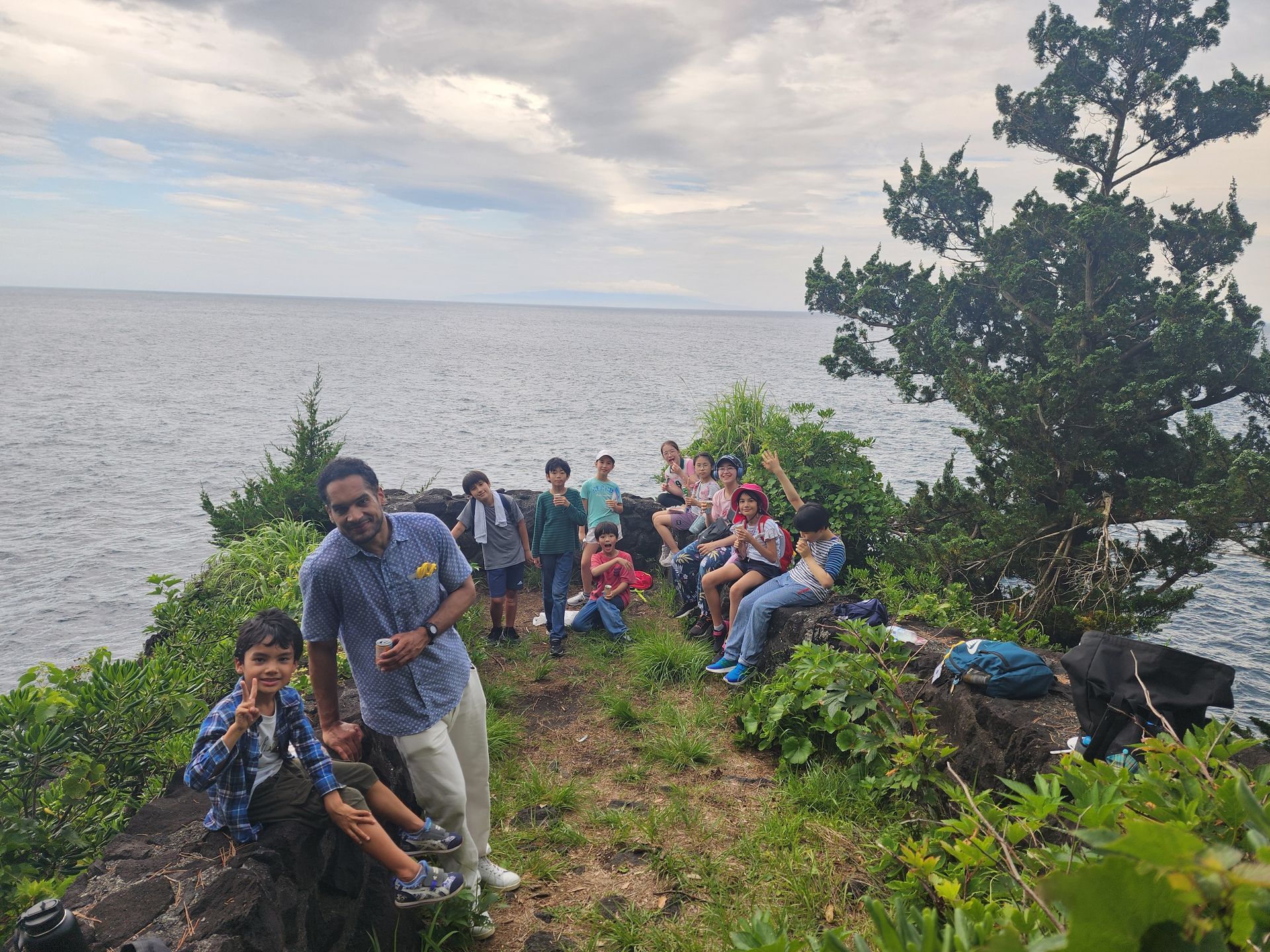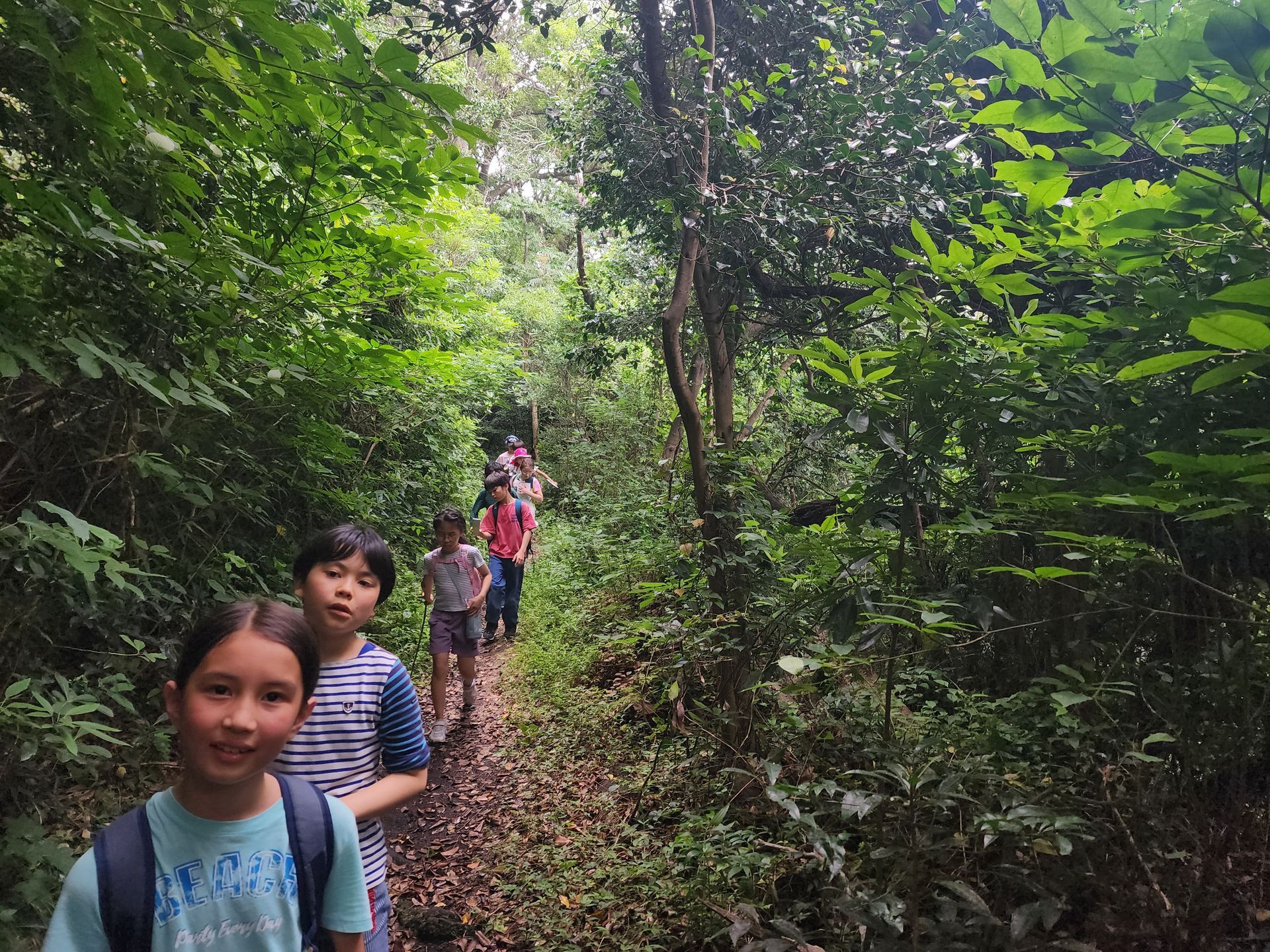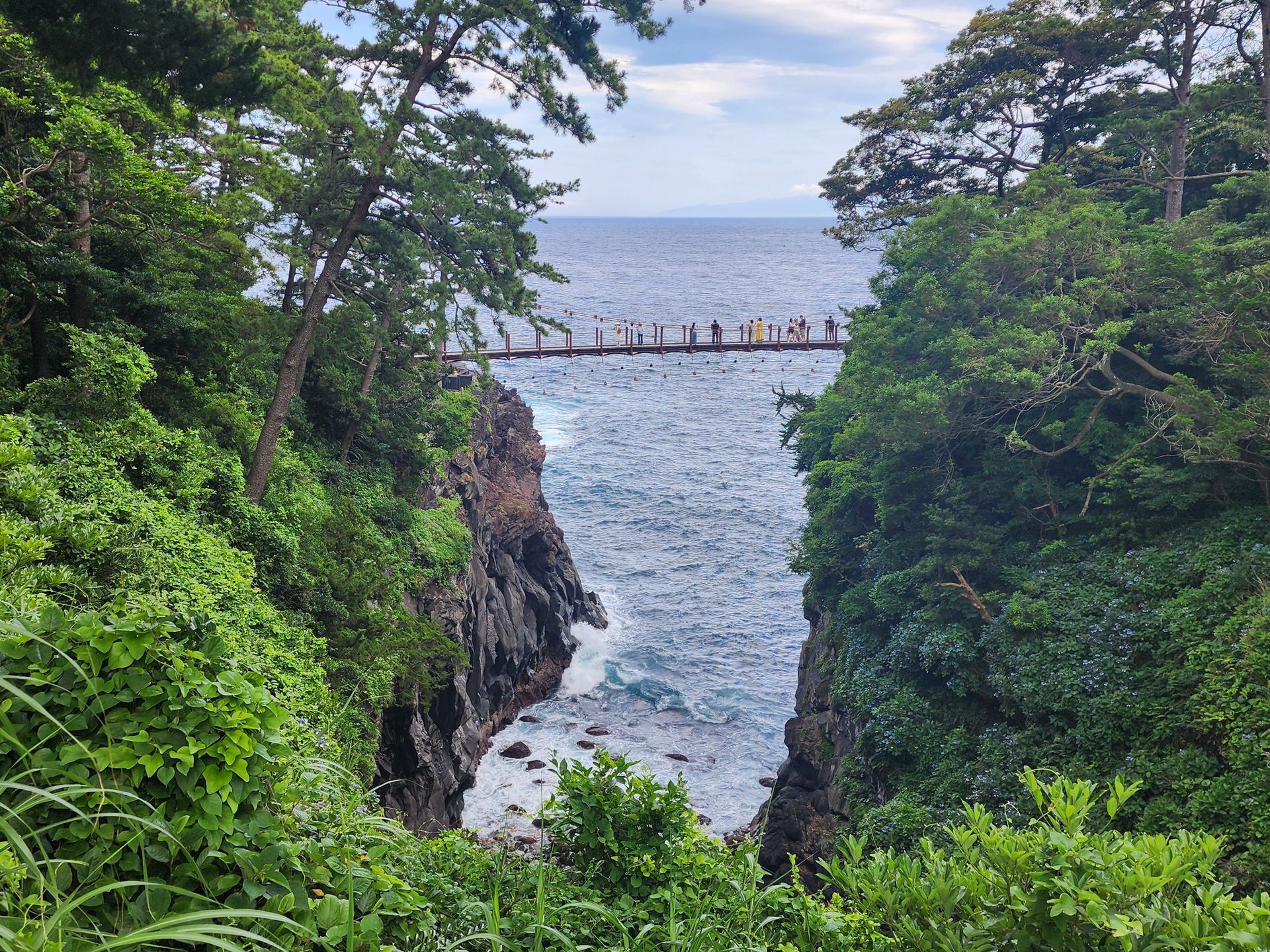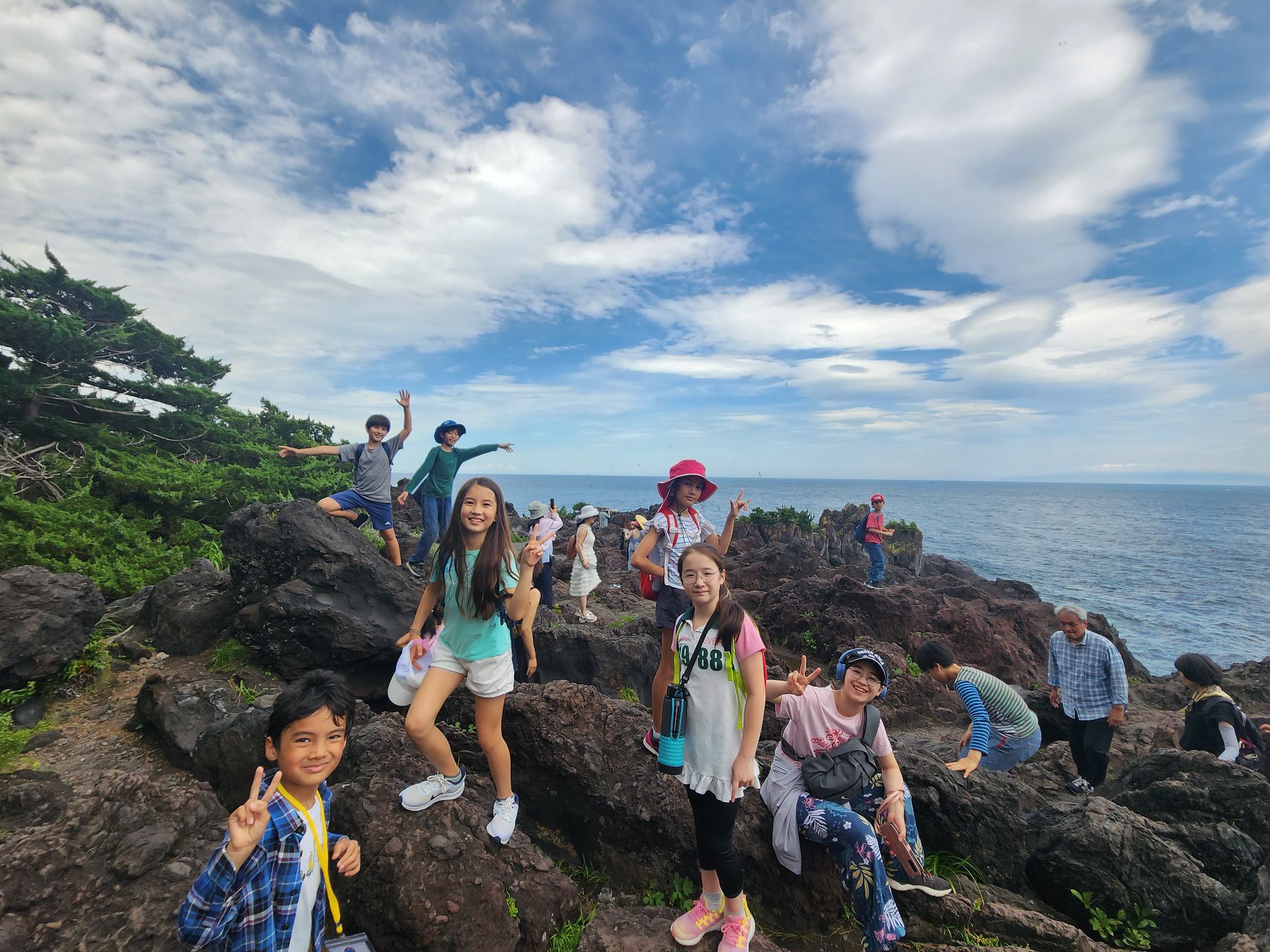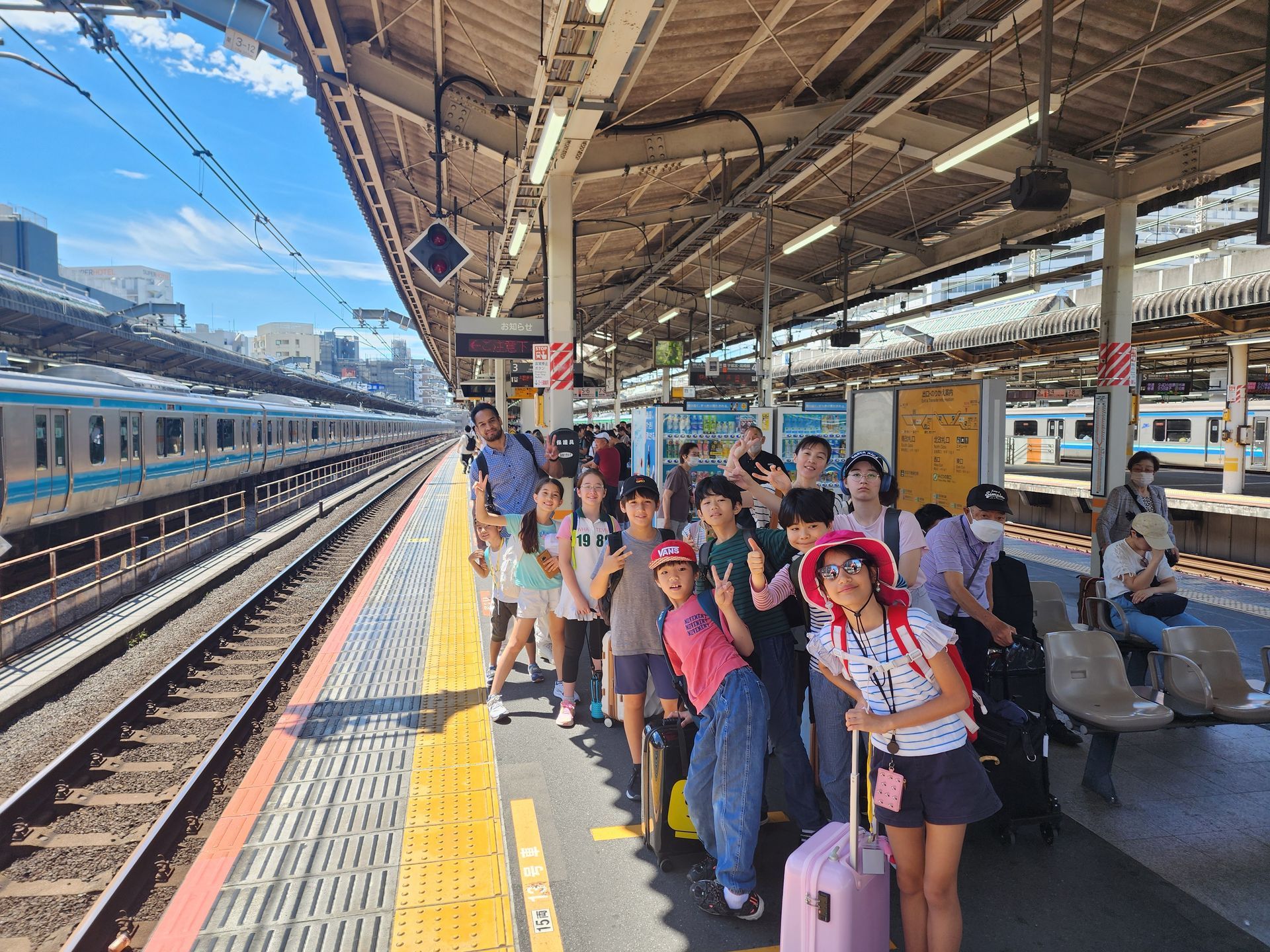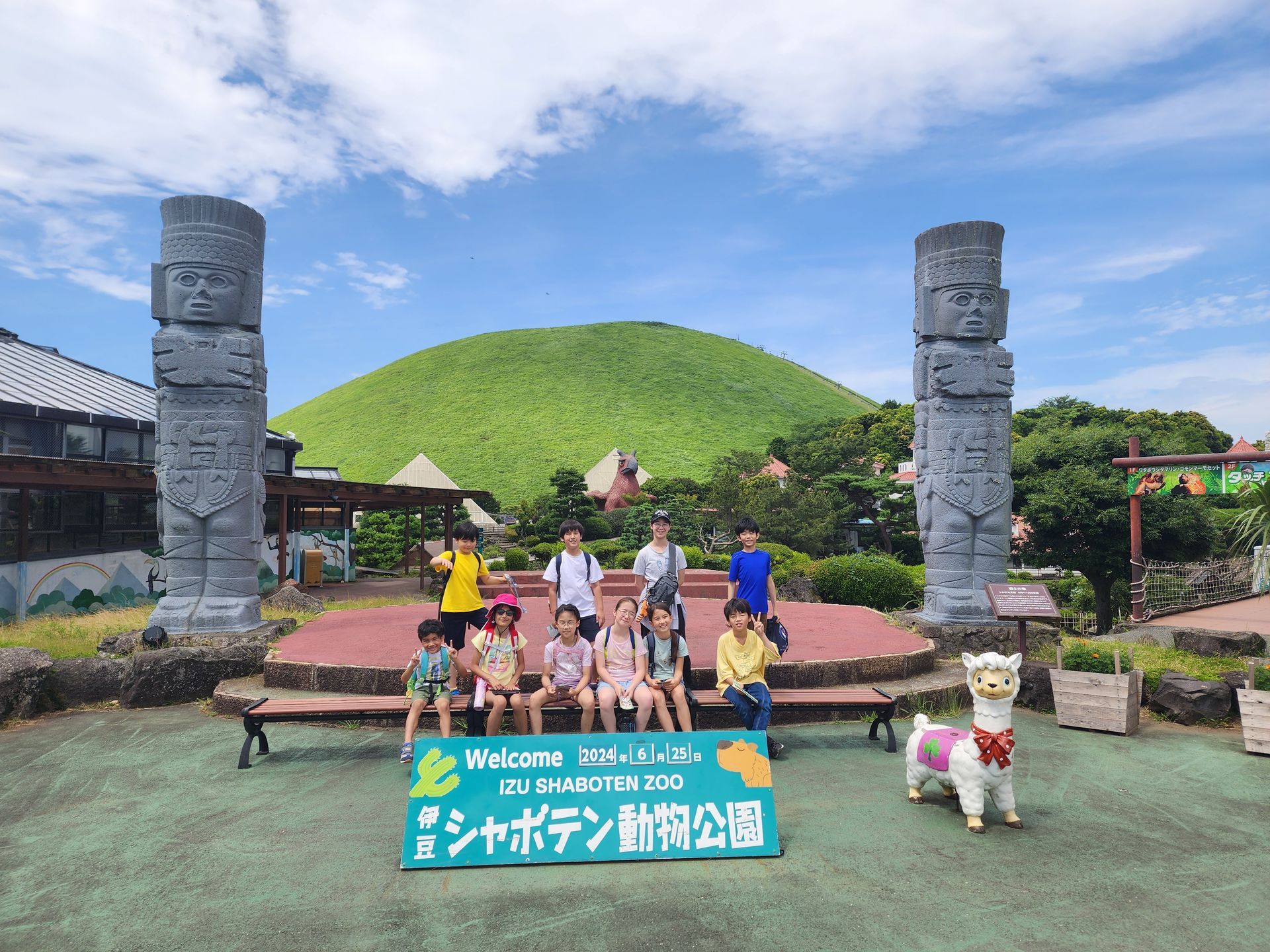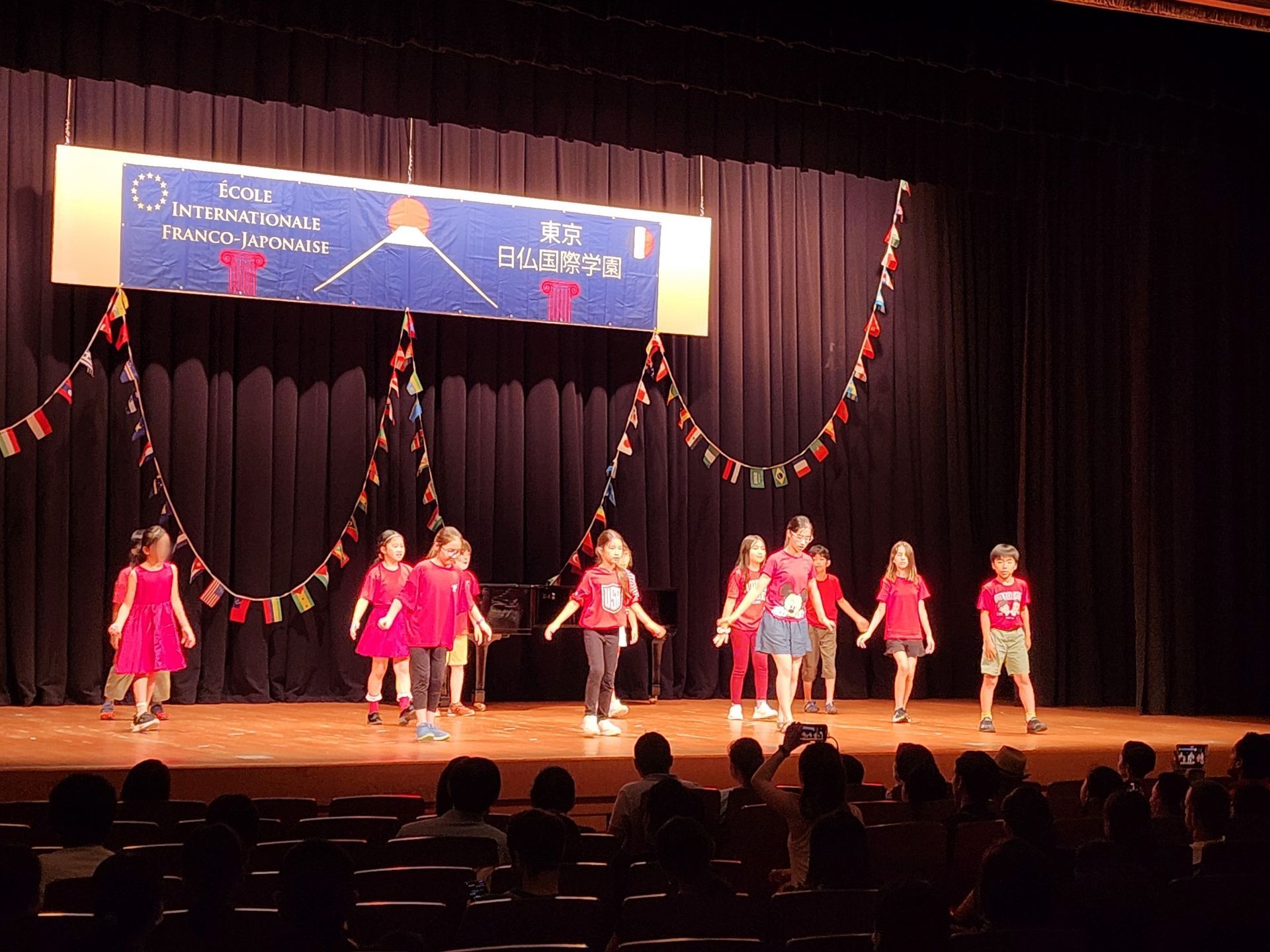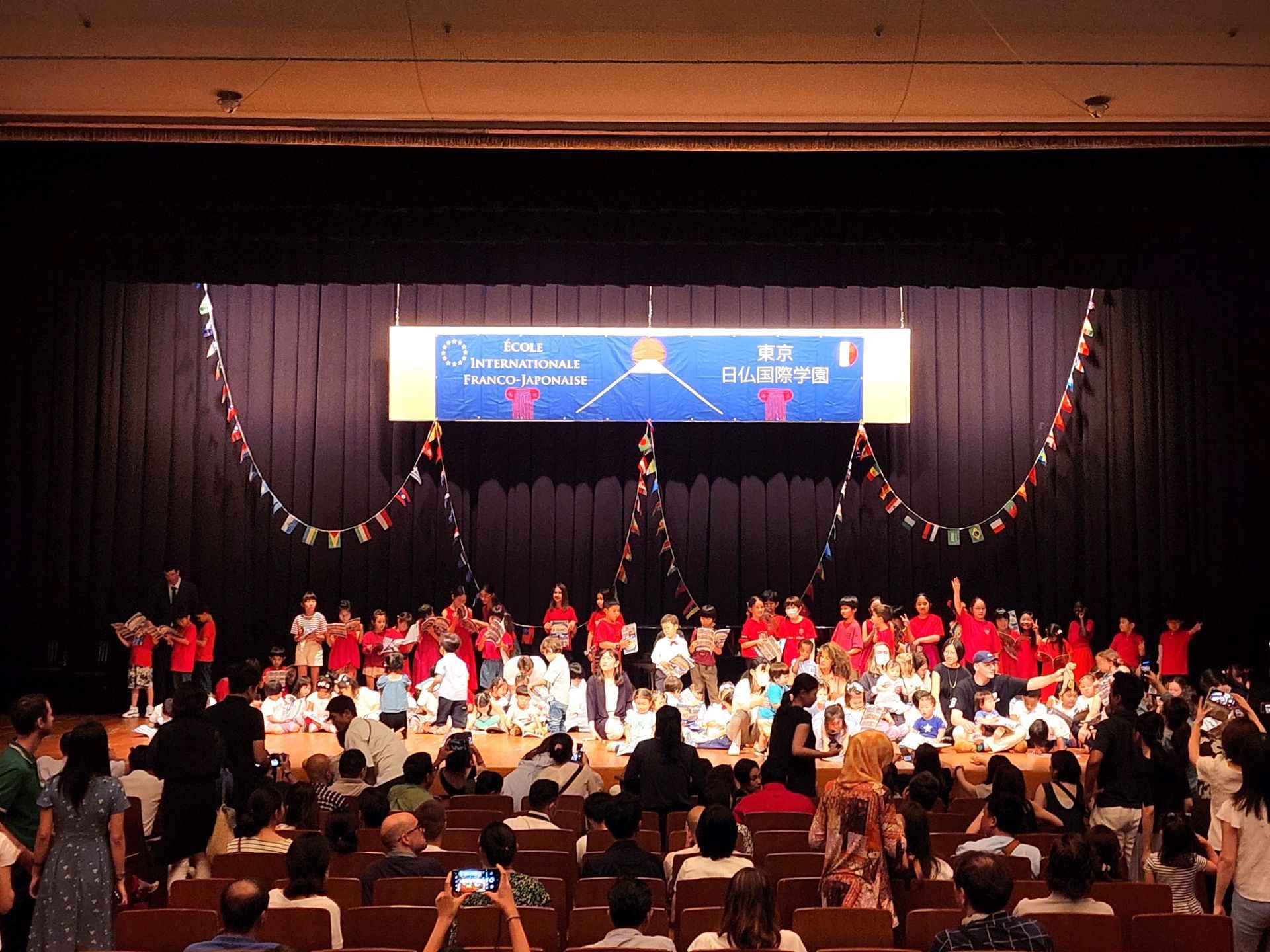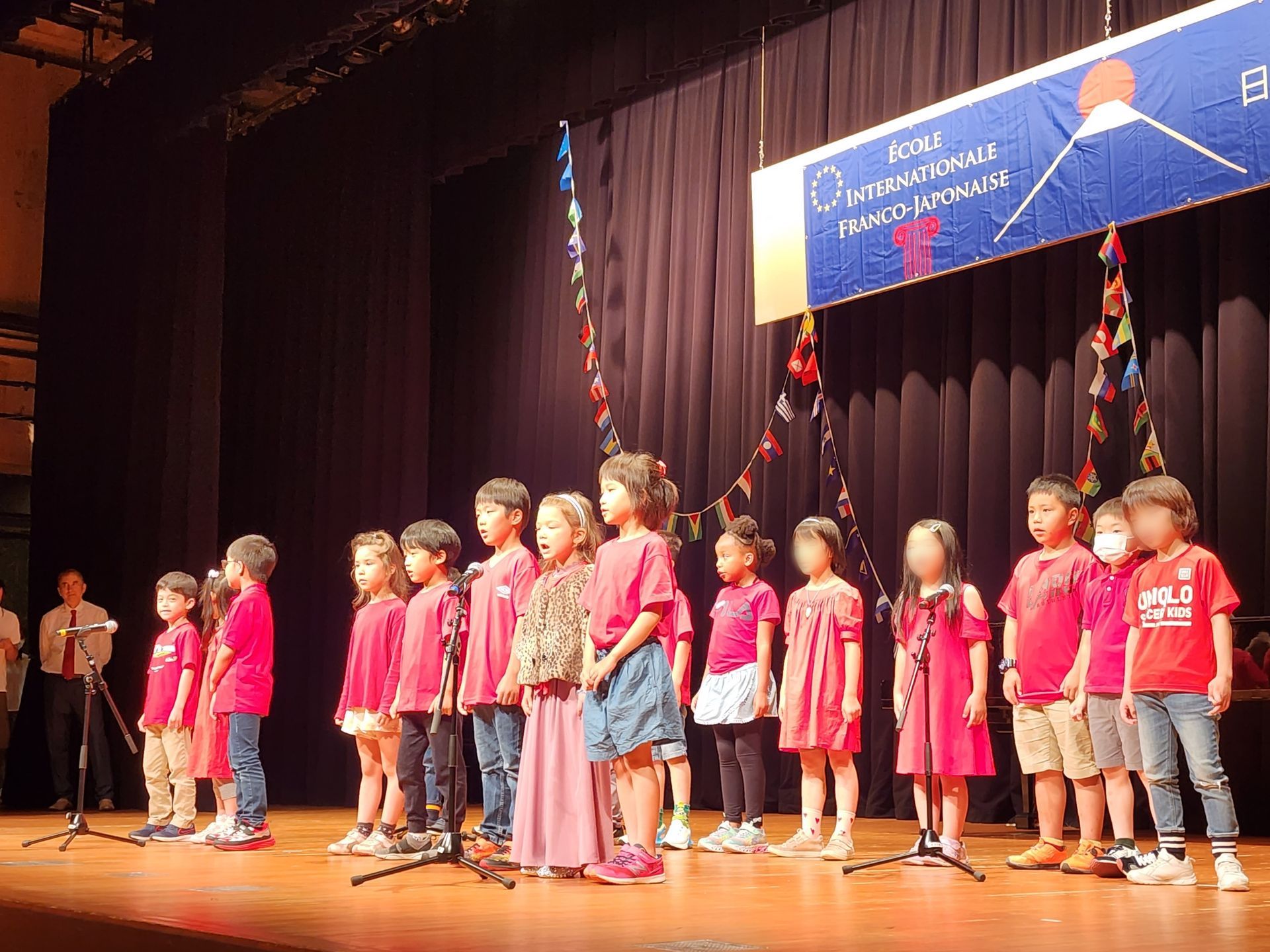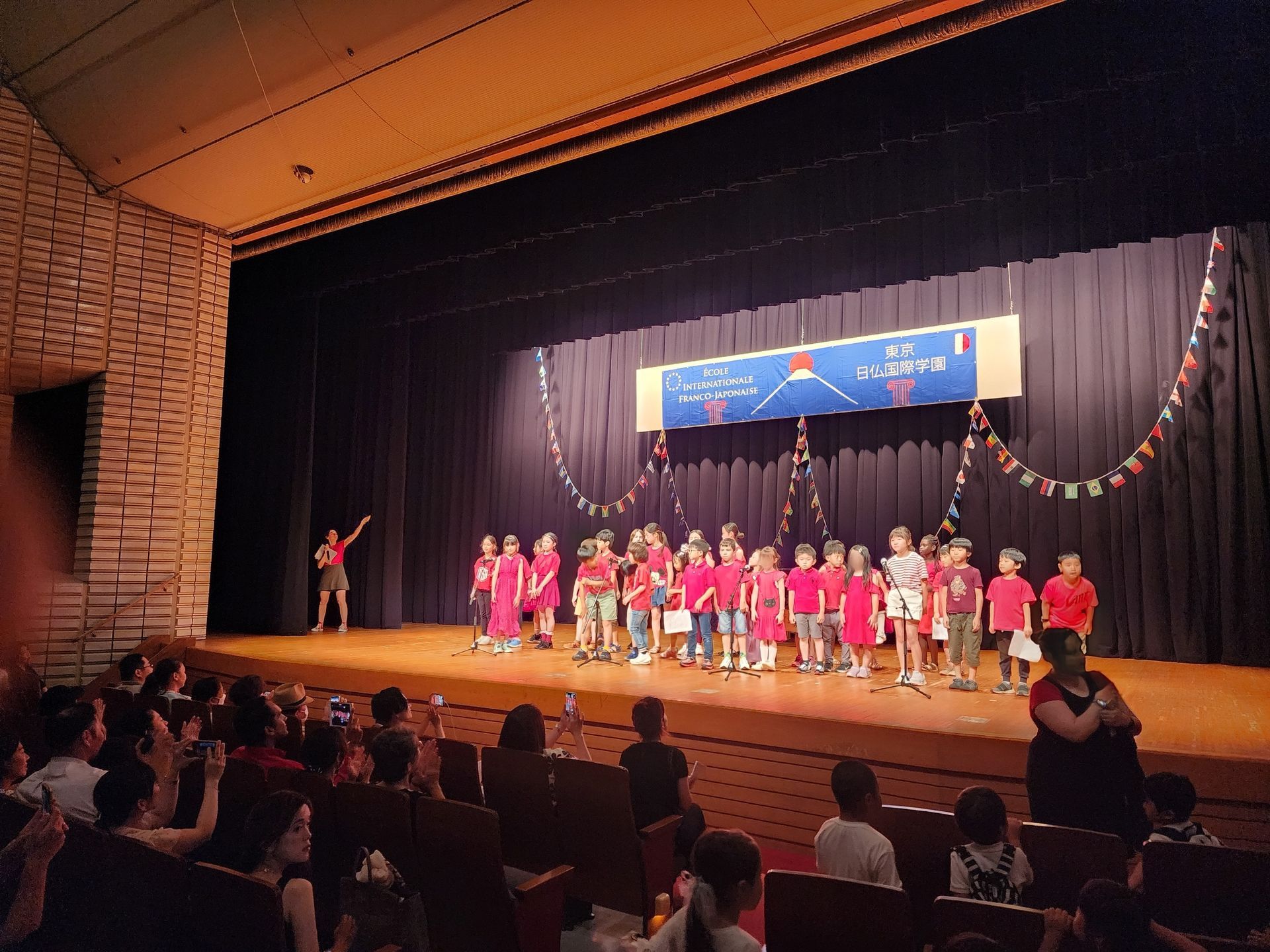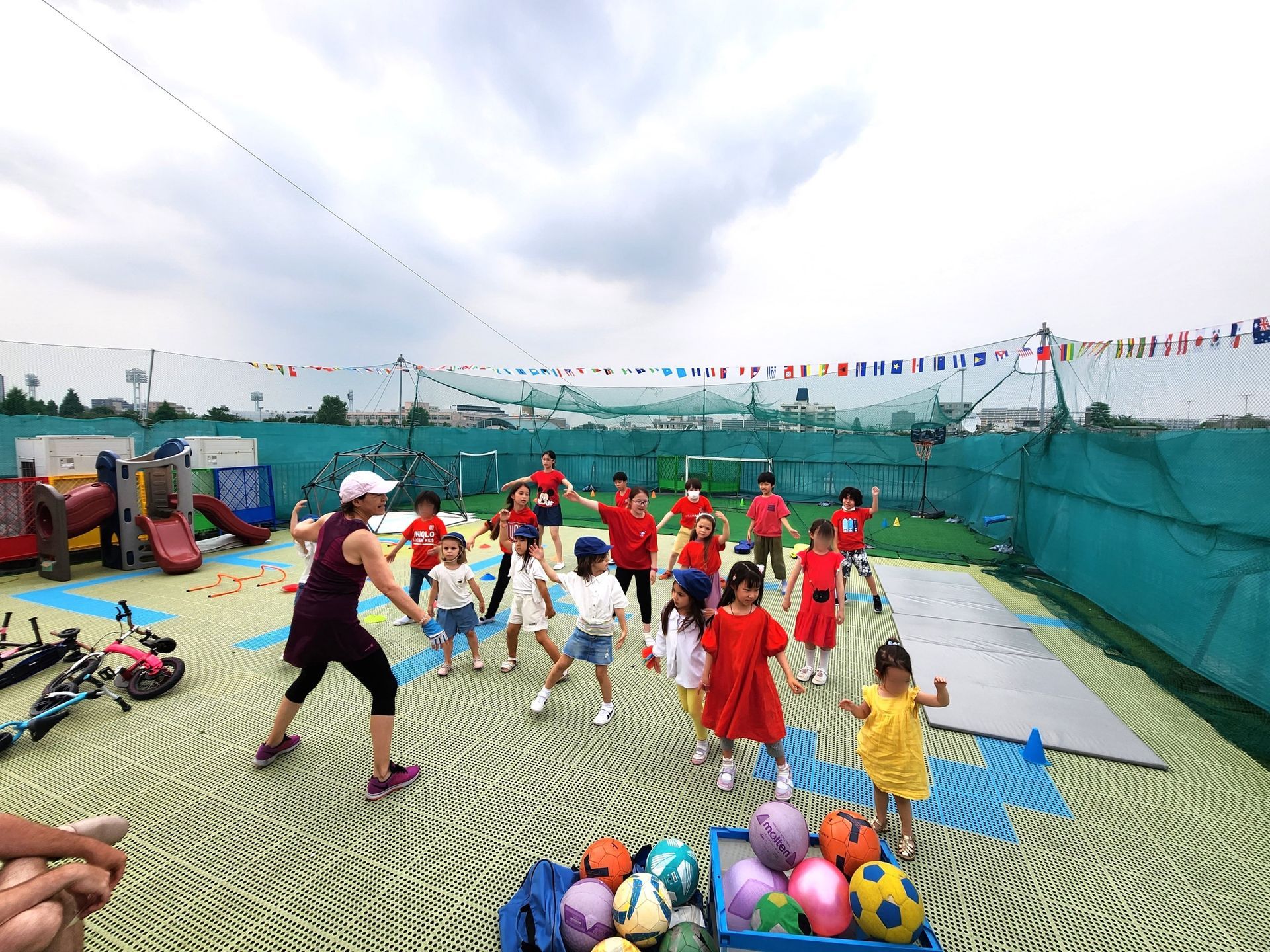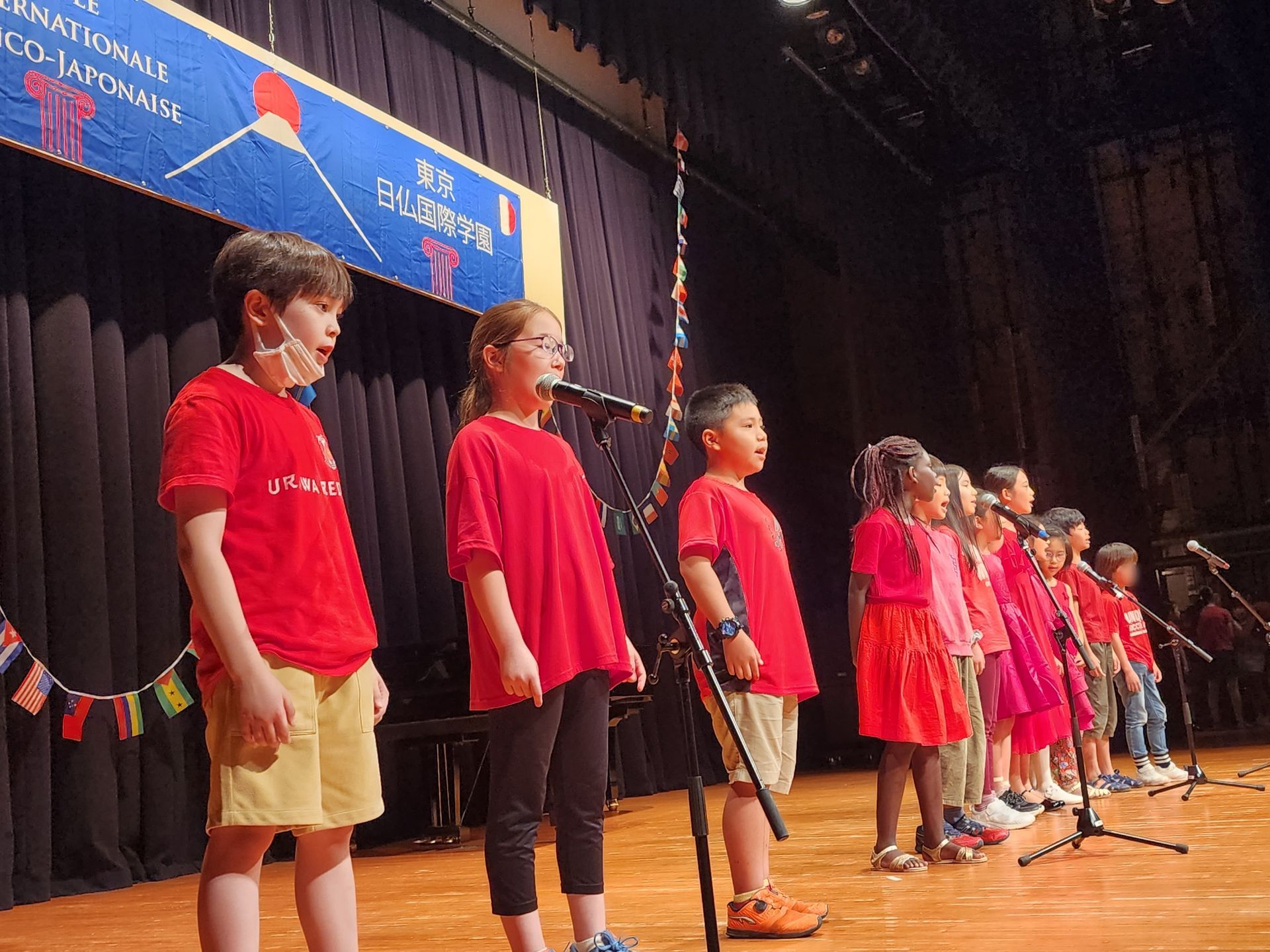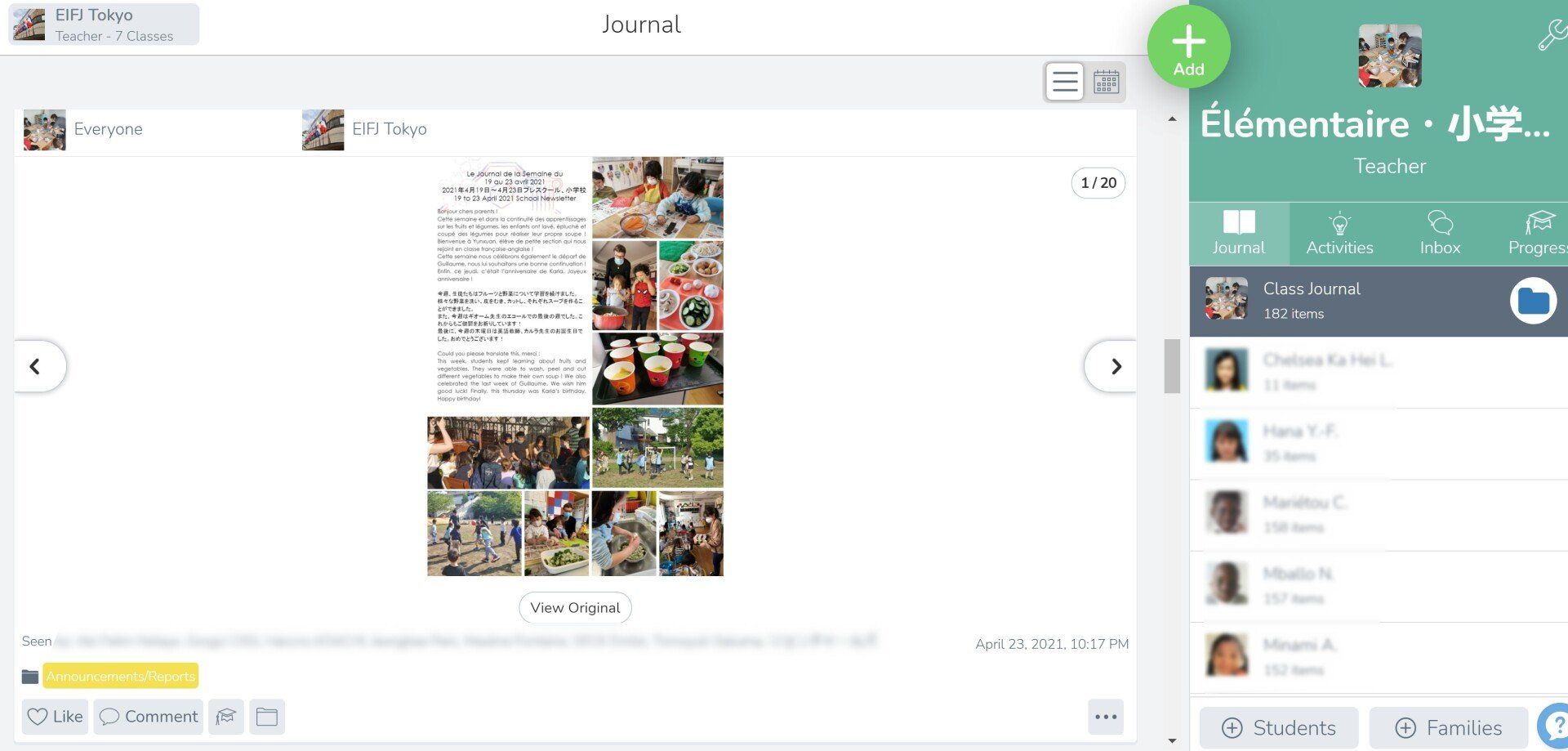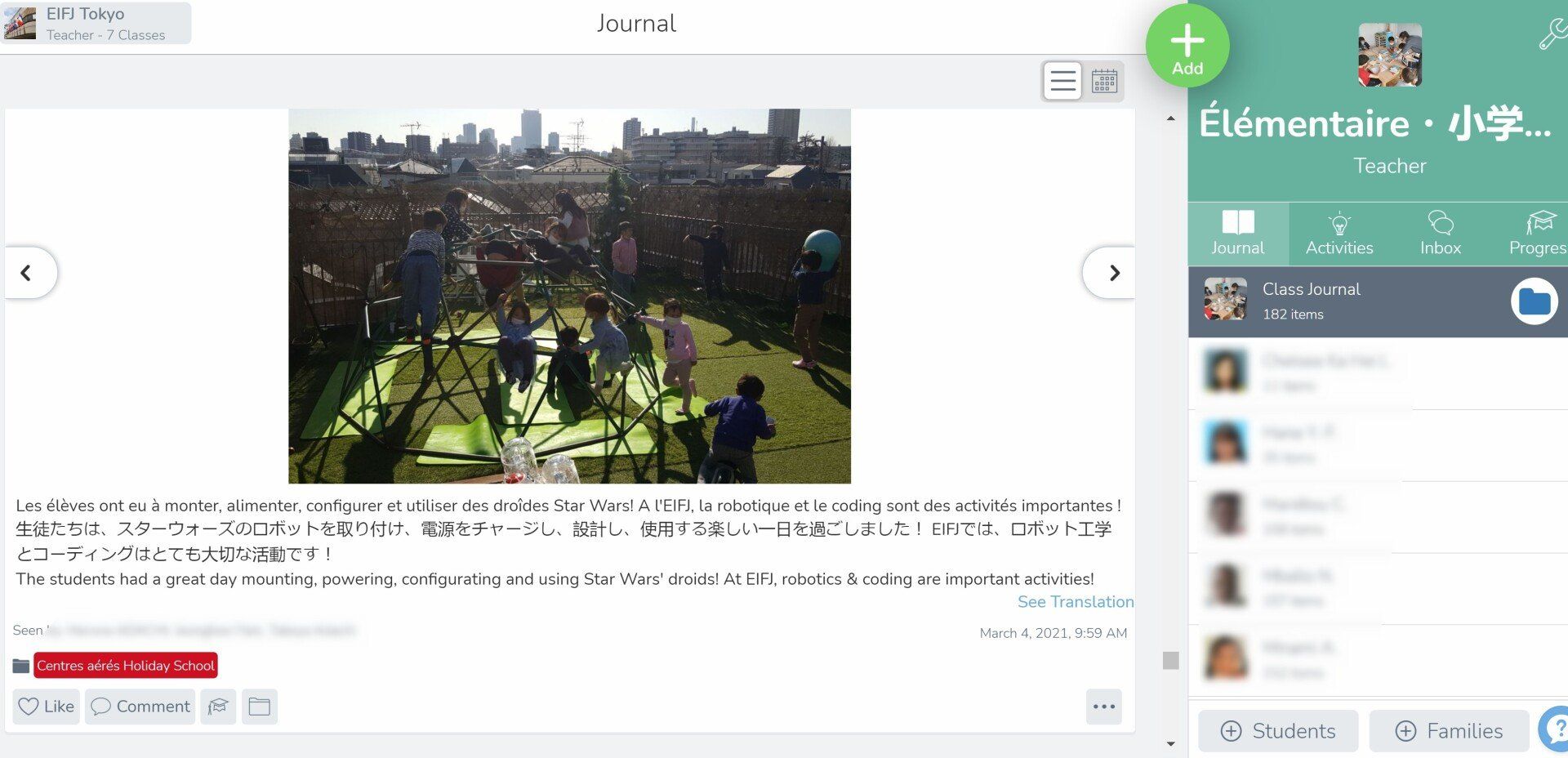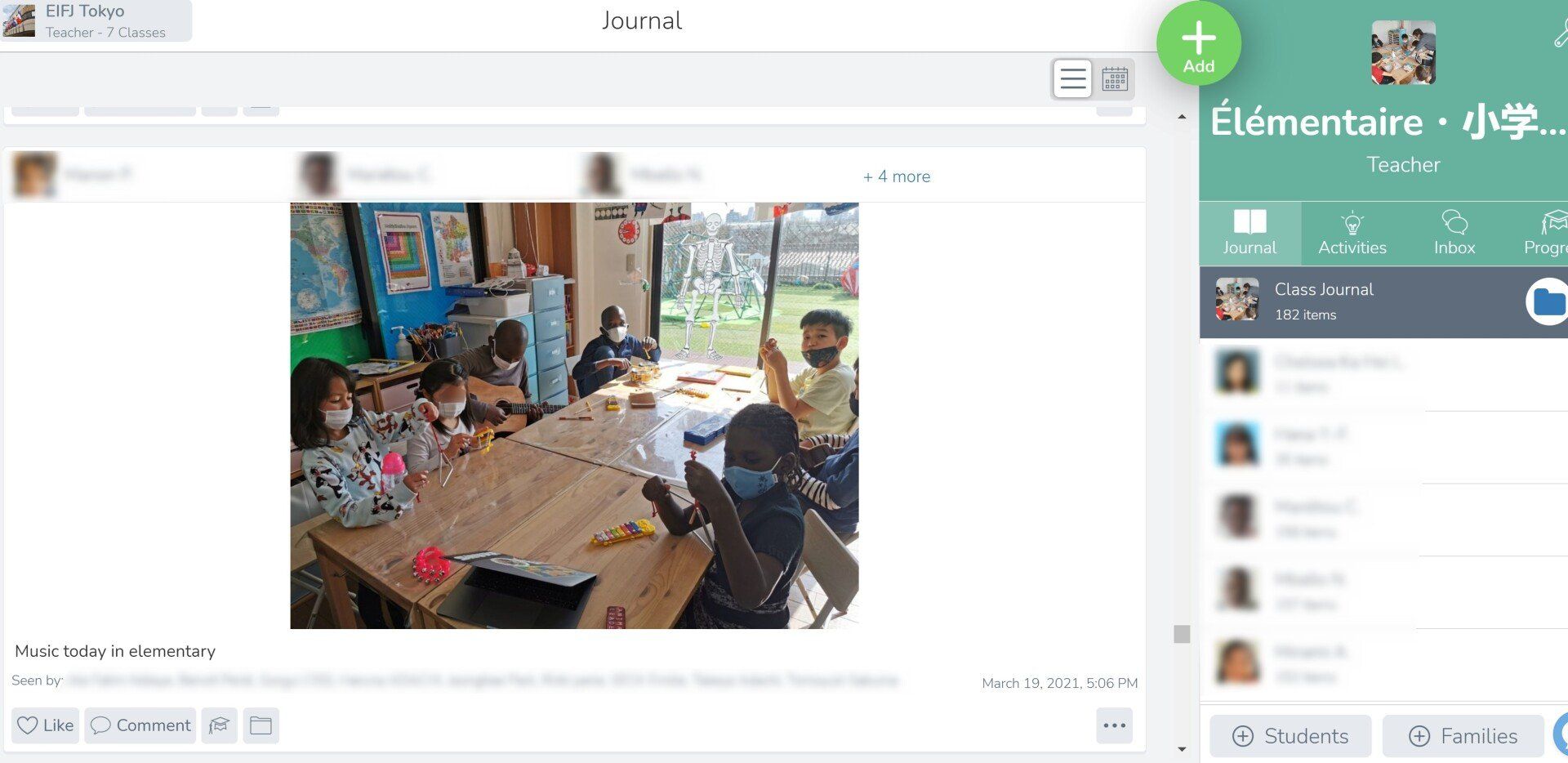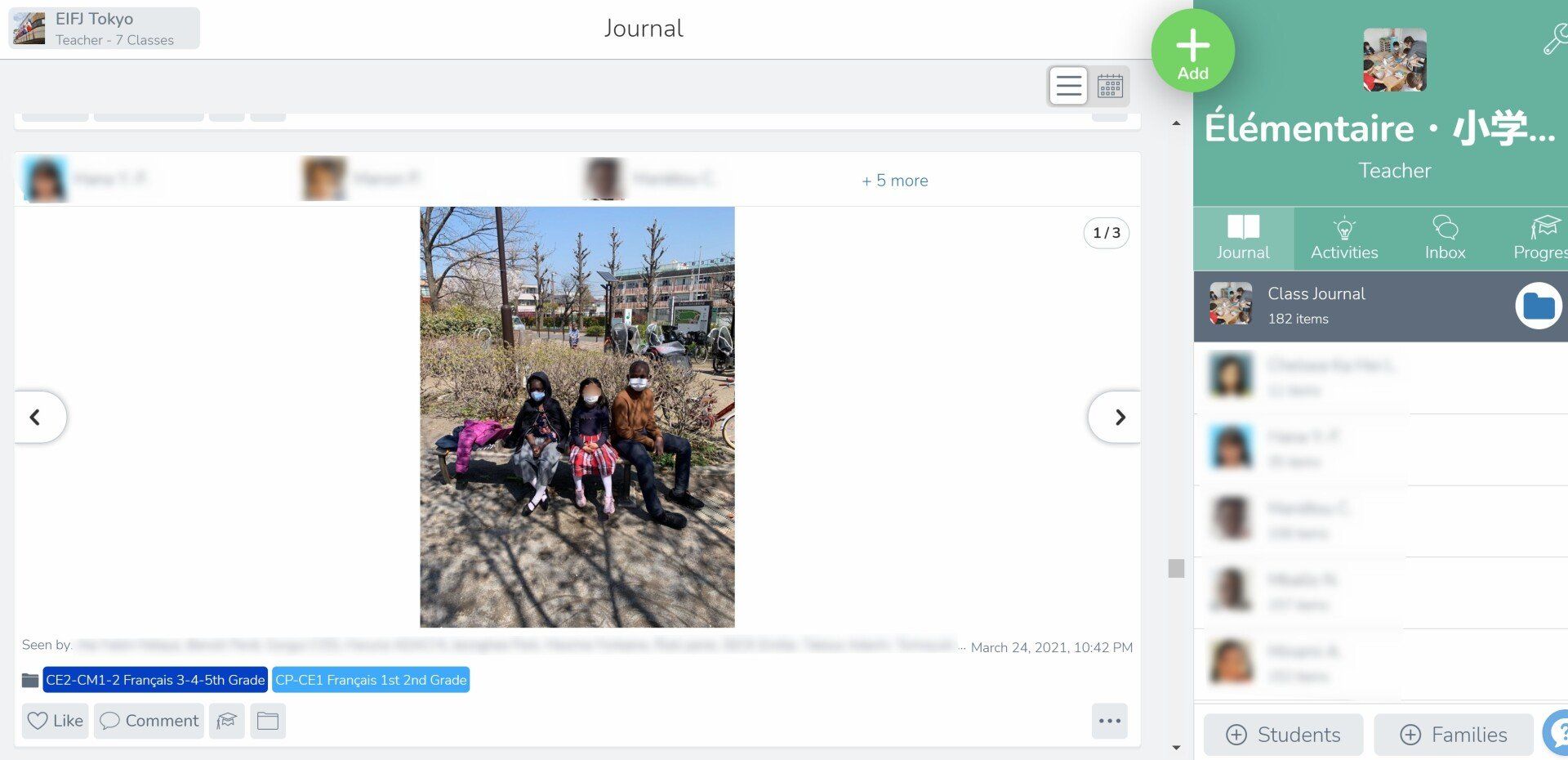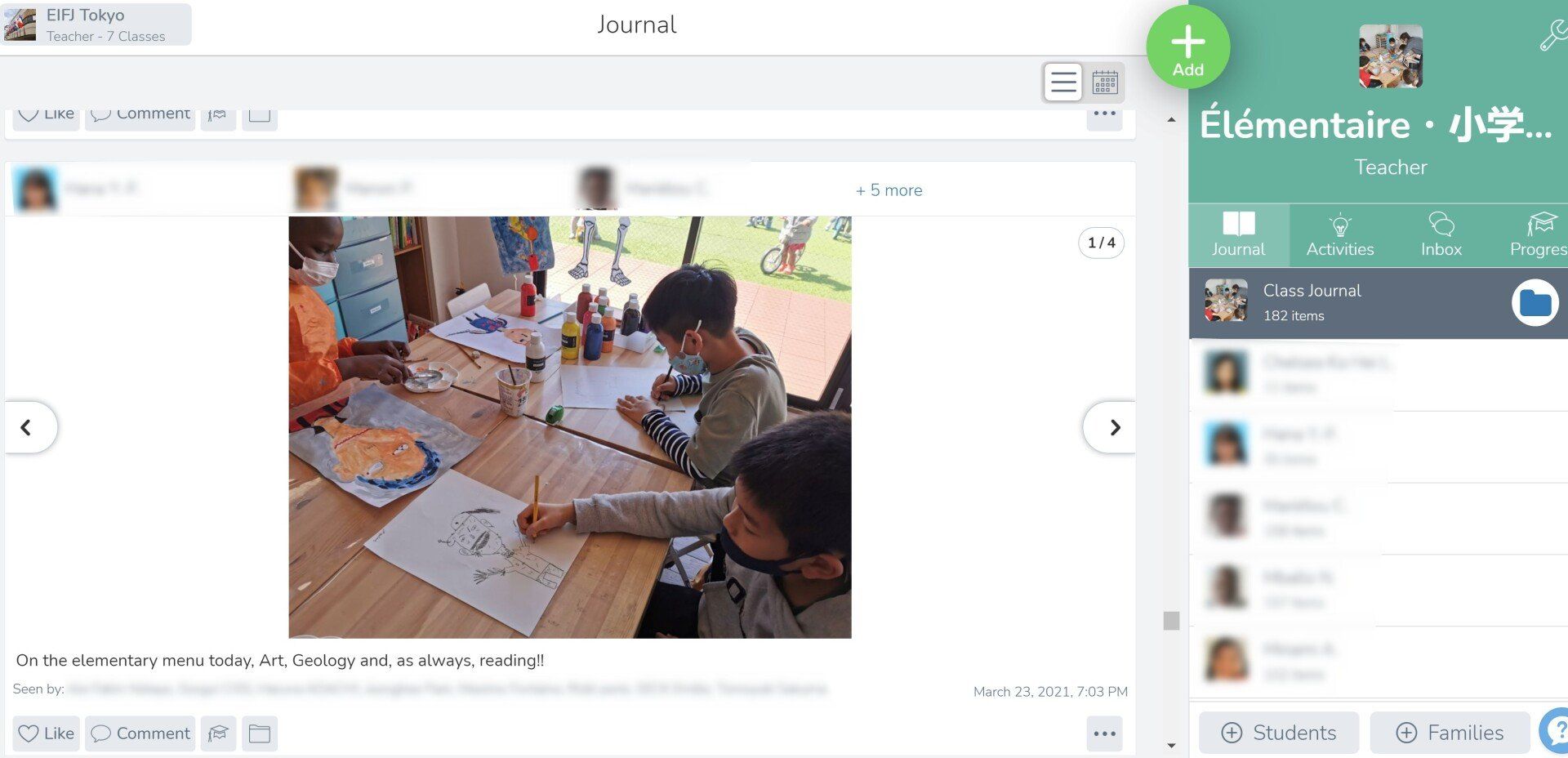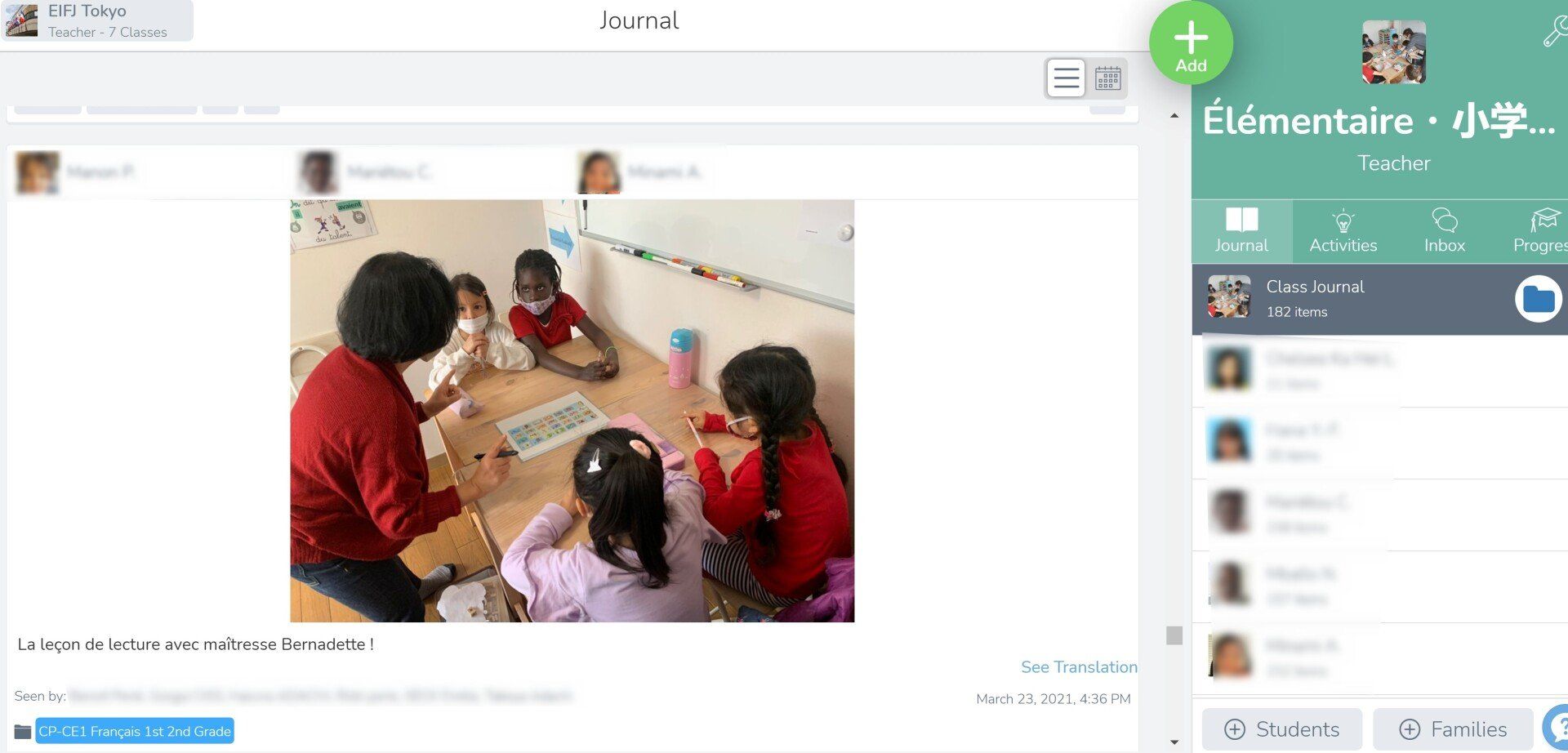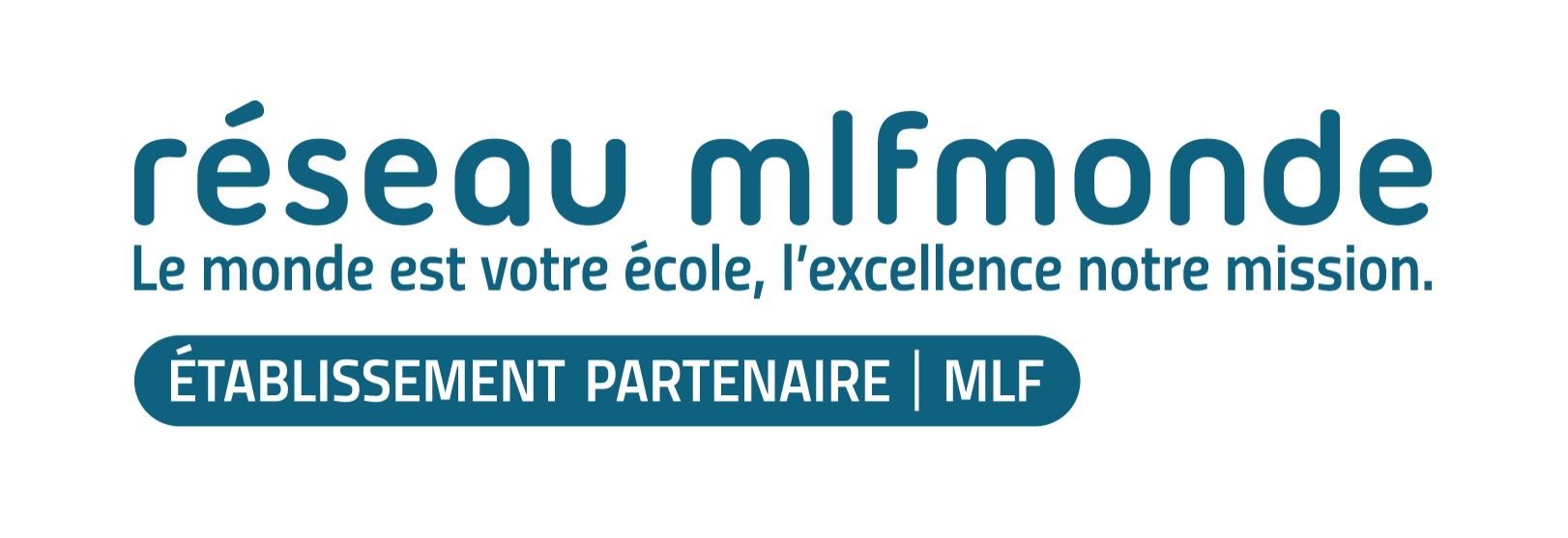FRENCH-ENGLISH BILINGUAL ELEMENTARY +JAPANESE
A unique program in Japan
AT THE FRENCH-JAPANESE INTERNATIONAL SCHOOL OF TOKYO
Academic excellence in an encouraging teachers-students' ratio environment
The only Bilingual French-English, +Japanese, in Japan
Campus of 150 places
Government subsidies up to the end of 1st Grade (37,000 to 97,000 yen monthly depending on municipalities)
Differentiation and splitting mechanism, progress and successful middle school entrance
Aiming for all programs' accreditations
Open year-round upon demand (and based on the staff's availability) from 7:30 a.m. to 8 p.m.
A team dedicated to the success of all our students
French Ministry of Education curriculum, International Baccalaureate Primary Years Programme candidacy
Complementary educational activities (APC) every Wednesday (45mn), FLE, ESL & JSL support, homework assistance
Embracing a proven educational model implemented in accredited French international schools, a member of mlfmonde network, EIFJ follows the curriculum of the French Ministry of National Education, and is a candidate for International Baccalaureate (IB) Primary Years Programme (PYP) accreditation.
Of the 24 hours of teaching per week, 12 hours are taught in French and 12 hours in English (French 50%, English 50%), and additionally, two hours of Japanese are offered.
The 24 + 2 hours of weekly teaching can be supplemented daily by Japanese, English and French classes, and extracurricular activities (art, science, sports, music, etc.) starting at 15:45. It is therefore possible for a student to optionally receive for example up to 7 hours of Japanese lessons per week.
The primary mission of EIFJ is to provide students with strong academic skills. Cycle 2 (Grade 1, 2, and 3) is the cycle of the acquisition of fundamental knowledge: reading, writing, counting, calculating and solving problems. Cycle 3 (Grade 4, 5 and 6) is the consolidation cycle.
As a candidate school for the IB Primary Years Programme (PYP), we enrich this strong academic foundation with a global, inquiry-based approach that fosters curiosity, creativity, and critical thinking.
Students explore key concepts, connect learning across subjects, and apply their knowledge in real-world, meaningful contexts. This approach cultivates confident, reflective, and internationally minded learners, well prepared for the future.
This alignment enables students to transition smoothly into French, international, or IB schools in Japan and abroad. It also provides access to over 5,000 IB World Schools and more than 600 French international schools, including those in the renowned Mission Laïque Française, AEFE, and other accredited global networks.
In the French-English program, Japanese lessons in the elementary and middle school follow an adapted curriculum designed to build both language skills, cultural and historical knowledge. Using selected MEXT-approved textbooks and learning materials, students engage in continuous practice of hiragana, katakana, and a progressive introduction to kanji suited to their level. Lessons also explore Japanese culture, history, and geography, helping students develop a rich understanding of Japan’s traditions, society, and regional diversity. Students are often grouped by proficiency so that both beginners and more advanced learners receive instruction tailored to their abilities.
The program brings together the five main areas of learning:
1. Languages for thinking and communicating
- Understand, express yourself using the French language, both orally and in writing
- Understand, express yourself using a foreign language
- Understand, express yourself using mathematical, scientific and computer languages
- Understand, express yourself using the languages of the arts and the body
2. Methods and tools for learning
3. The training of the person and the citizen
4. Natural systems and technical systems
5. Representations of the world and human activity
EIFJ's mission is also to promote international understanding through bilingual education, the mixing of cultures and constant educational innovation.
We strive daily to develop and consolidate social skills: respecting others, communicating with fellow human beings in a multilingual and multicultural community, learning to live together are essential assets for a balanced and fulfilling adult life,
The class begins at 8:30 with a students' welcoming, the first communication time of the day (date, attendance, agenda, questions about homework, discussions & revisions)
- 9:00: dictation and mental arithmetic
- 9:15: differentiated workshop around the five areas of learning
- 10:15: recess on the rooftop, gym and library
- 10:30: differentiated workshop around the five areas of learning
- noon: lunch (meal provided by the family or the EIFJ cafeteria)
- 13:00: Japanese lesson
- 13:30: differentiated activities
- 15:00: homework writing
- 15:30: end of lessons
- 15:45: beginning of the after-school activities
In addition to our secure, fully-equipped rooftop and the gym, the library contains French, Japanese and English books; board games and a gymnasium are available to students.
PEDAGOGICAL PROJECTS CONDUCTED DURING THE SCHOOL YEAR
- September:
- National Air Quality Day (Middle School, Cycle 4)
- National School Sports Day (JNSS) (Elementary and Middle School)
- October:
- Climate Week (Grades 4-5 and Middle School, Cycles 3 and 4)
- Taste Week (Kindergarten, Elementary, Middle School, Cycles 1, 2, 3 and 4, projects related to sensory awakening, discovering flavors, balanced diet)
- Science Festival (Kindergarten, Elementary, Middle School, Cycles 1, 2, 3 and 4)<<<
- October 16: World Food Day (Cycles 1, 2, 3 and 4)
- October 17: International Day for the Eradication of Poverty (Middle School, Cycle 4)
- November:
- November 11: Participation at the French Embassy in the Ceremony commemorating the Armistice of November 11, 1918
- 2nd Thursday of November: Anti-Bullying Day at School (Elementary, Middle School, Cycles 2, 3 and 4)
- November 20: International Children's Rights Day (Kindergarten, Elementary, Middle School, Cycles 1, 2, 3 and 4)
- European Week for Waste Reduction (Middle School, Cycle 4)
- December:
- December 9: Laïcité Day (Secularism Day) (Elementary and Middle School, Cycles 2, 3 and 4, work on the values of the Republic, freedom of conscience, equality)
- December 20: International Human Solidarity Day (Cycles 2, 3 and 4, from G1 to G7)
- January: January 27: International Holocaust Remembrance Day (Day of memory for genocides and prevention of crimes against humanity) (G4-5 and Middle School, Cycles 3 and 4)
- February: Safer Internet Day (Cycles 2, 3 and 4, Elementary and Middle School)
- March:
- March 8: International Women's Day (Elementary and Middle School, Cycles 2, 3 and 4)
- Maths Week (Kindergarten, Elementary, Middle School, Cycles 1, 2, 3 and 4, participation in the Kangaroo and Koala Math contests)
- La Grande Lessive (The Big Wash - display of artistic creations)
- Poets' Spring (Kindergarten, Elementary, Middle School, Cycles 1, 2, 3 and 4)
- March 22: World Water Day (Elementary and Middle School, Cycles 2, 3 and 4)
- April:
- April 22: Earth Day (Kindergarten, Elementary, Middle School, Cycles 1, 2, 3 and 4)
- April 23: World Book and Copyright Day (World Book and Storytelling Day), and English Language Day
- May / June: European Sustainable Development Week (Cycles 2 and 3, from G1 to G5)
- June 8: World Oceans Day (Middle School, Cycle 4)
EVENTS BRINGING TOGETHER THE FRENCH, BINATIONAL, JAPANESE, AND THE INTERNATIONAL COMMUNITY (Calendar)
- September: Family orientation and welcome picnic, class photos
- October: Kita-ku Furusato Kumin Festival, French and International Schools of Japan's Run, Halloween Haunted House Hunt
- November: Kita-ku Nishigaoka Family Festival, school integration trips, Thanksgiving
- December: Christmas concerts and parties
- January: King's cake celebration (Galette des Rois), French-German Day, Snow Day
- February: Candlemas (Chandeleur), Setsubun, Lion Dance (Shishimai)
- March: Mardi Gras (Fat Tuesday), Saint Patrick's Day, Japanese Academic Year Graduation Ceremony
- April: April Fool's Day, Spring School Marathon, Hanami picnic, Koi no Bori (Carp Streamers), Easter egg hunt
- May: Europe Day and welcoming of a European Union Ambassador
- June: End-of-Year School Concert and Graduation Ceremony
- July: Tanabata Festival, Children's Bastille Day (14 July)
- August: Sea festival
2025-2026 CLASSES
- Bilingual First Grade (6 years)
- Bilingual Grade 2 & 3 (7~8 yrs)
- Bilingual Grade 4 & 5 (9~10 yrs)
Depending on the increase in the students' headcount, single-grade classes will be created.
Citizenships of students enrolled in EIFJ programs as of September 2025: French, American, Japanese, Polish, Irish, French-Japanese, French-Chinese, Japanese-Chinese, American-Japanese, Chinese, Mexican, Bulgarian, Taiwanese, Turkish, Senegalese, Korean, Mongolian, Canadian, Australian, Algerian, Vietnamese, Malaysian, Egyptian.
DIFFERENTIATION & SPLITTING MECHANISM
Language development and fluency in French (Japanese and English as well) are one of the priorities of EIFJ program. How to learn in a multilingual, multicultural and multi-level classroom? EIFJ Tokyo rethinks differentiation by setting up a splitting mechanism allowing everyone to progress according to each student’s level and needs. EIFJ “French as a Foreign Language” (FLE) teachers intervene during the French and language study sessions: they take responsibility of the group of students who are new to the French language, as needed, daily and within the framework of a dedicated language learning and consolidating workshop, hence benefiting from the experience of our teachers and teaching methods specific to FLE. This unique mechanism allows these students to acquire sufficient language skills, to return to the main course daily led by the certified teacher, and to follow the official program with students whose mastery of French is advanced or in accordance with the expectations of their age. In addition to this remarkable system, intensive courses in FLE (French), ESL (English), JSL (Japanese) as well as other languages are offered every day as part of extracurricular activities.
CALENDAR
Classes are held five days per week, Monday to Friday. Although we highly encourage, for obvious pedagogical reasons, students to attend all weekly classes (termly or annual tuition fees), it is possible to attend classes on a short-term childcare basis (hourly fees). The calendar is based on the French academic calendar, which is similar to other international schools' calendars. The school may open upon demand (and based on the staff's availability) at 7:30 a.m. and close at 8 p.m. EIFJ is closed during Japanese public holidays (short-term childcare is possible all-year-round, though, upon demand). Lessons are not provided during the term breaks, but very popular holiday schools are organized.
You can find out about tuition fees and information about scholarships by clicking here.
SPECIFIC INFORMATION RELATING TO THE EDUCATION PATH OF JAPANESE AND MIXED JAPANESE STUDENTS
Students’ transfers from EIFJ Tokyo to elementary, middle and high school in Japan are possible for those who wish. The double enrollment of Japanese or binational elementary students in a Japanese school and EIFJ Tokyo is recommended to comply with the education law, and equivalency is allowed through a close and permanent contact between the Japanese school and EIFJ Tokyo.
EIFJ LANGUAGE AGREEMENT
At EIFJ, we believe language is more than a tool for communication. It is a bridge to understanding, friendship, and global citizenship. As an IB World School in the Primary Years Programme (PYP) candidacy phase, we are committed to creating a learning environment where every student feels included, valued, and inspired to contribute.
Our community is proudly multilingual. Many of our students were born and raised in Japan, while others join us from around the world. To ensure all students can learn together, build lasting friendships, and share ideas openly, French and English are the primary languages of communication during the school day in classrooms, on the playground, and in shared spaces.
Using French and English at school enables students to:
- Engage fully in inquiry based learning experiences
- Collaborate effectively with classmates and teachers
- Include and support peers from diverse backgrounds
- Develop confidence in communicating across cultures
We value Japanese as an important part of our school and our students’ identities. Japanese is taught in dedicated classes and encouraged at home or outside of school hours, helping students maintain strong connections to their culture while thriving in an international learning environment.
This agreement reflects the IB Learner Profile and our mission to foster caring, open minded, and principled learners. By honoring our Language Agreement, students actively contribute to an inclusive, respectful, and globally minded community.
TRILINGUAL BIMONTHLY NEWSLETTERS' EXTRACTS
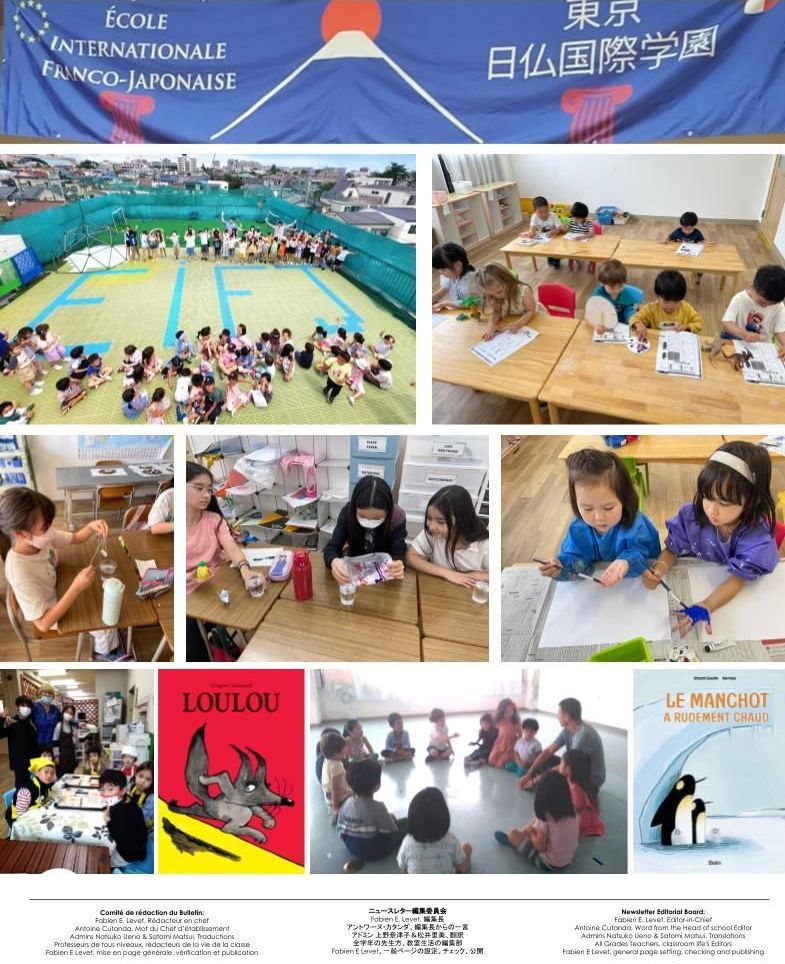

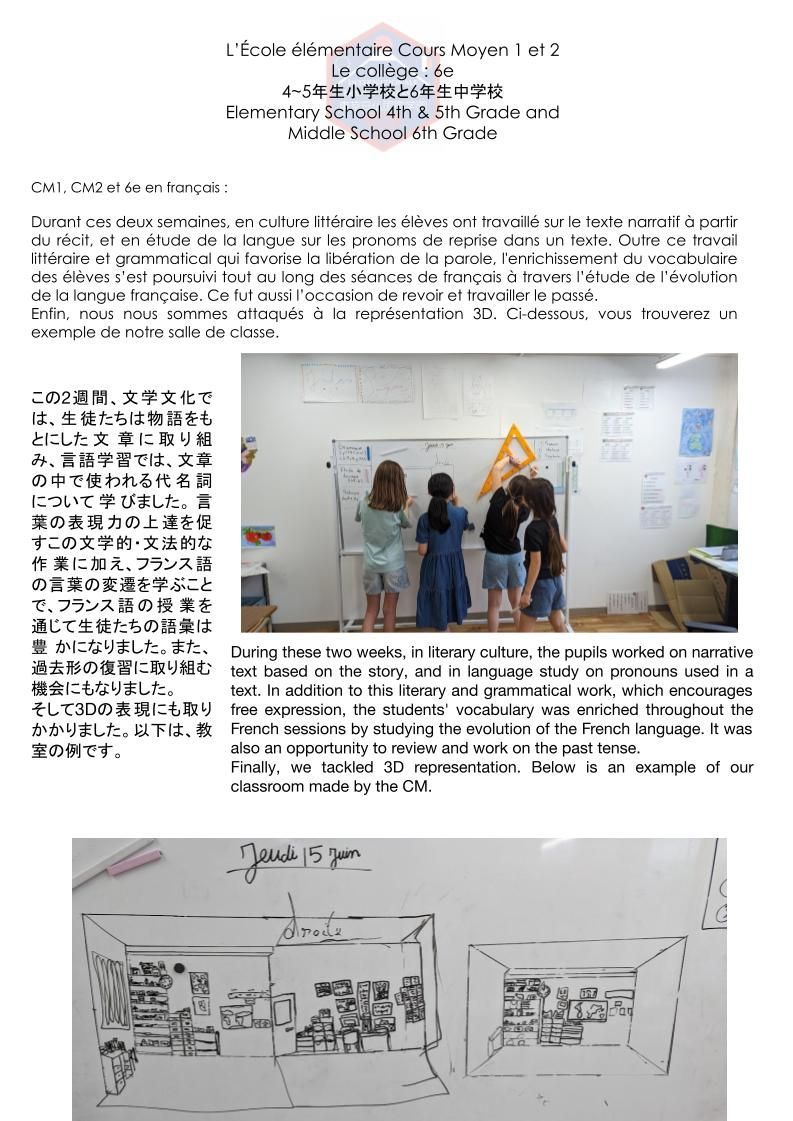


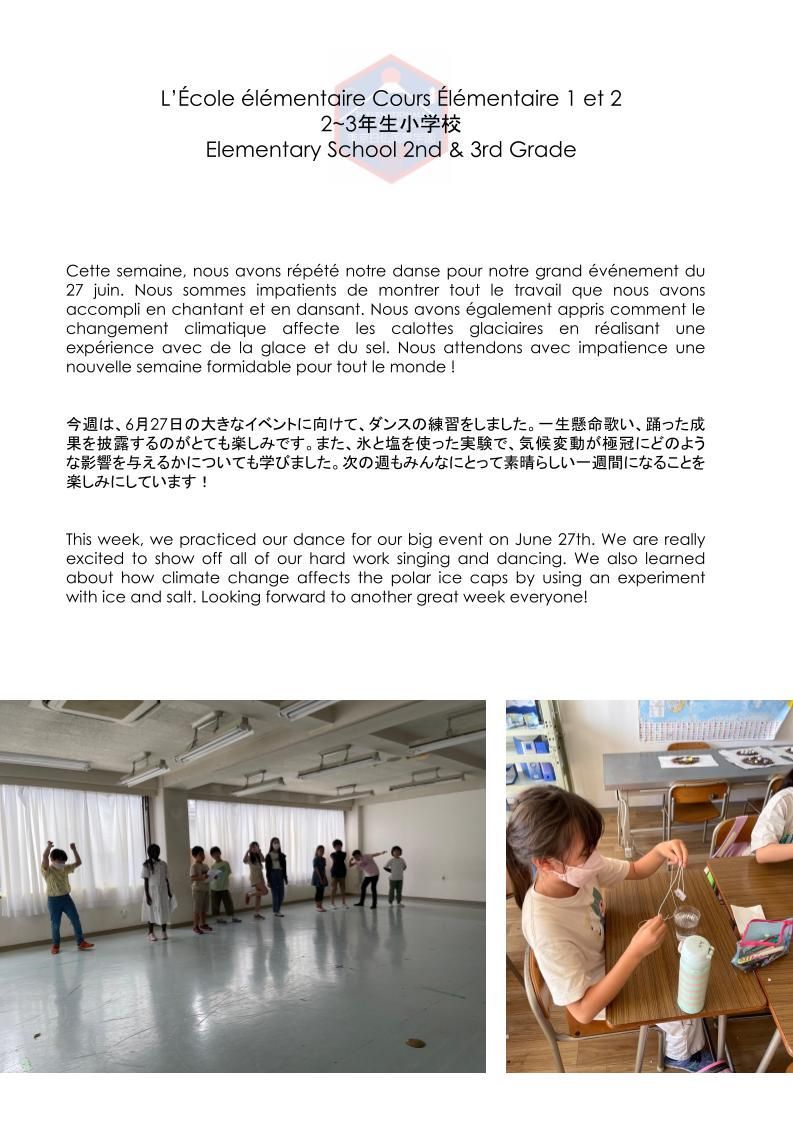

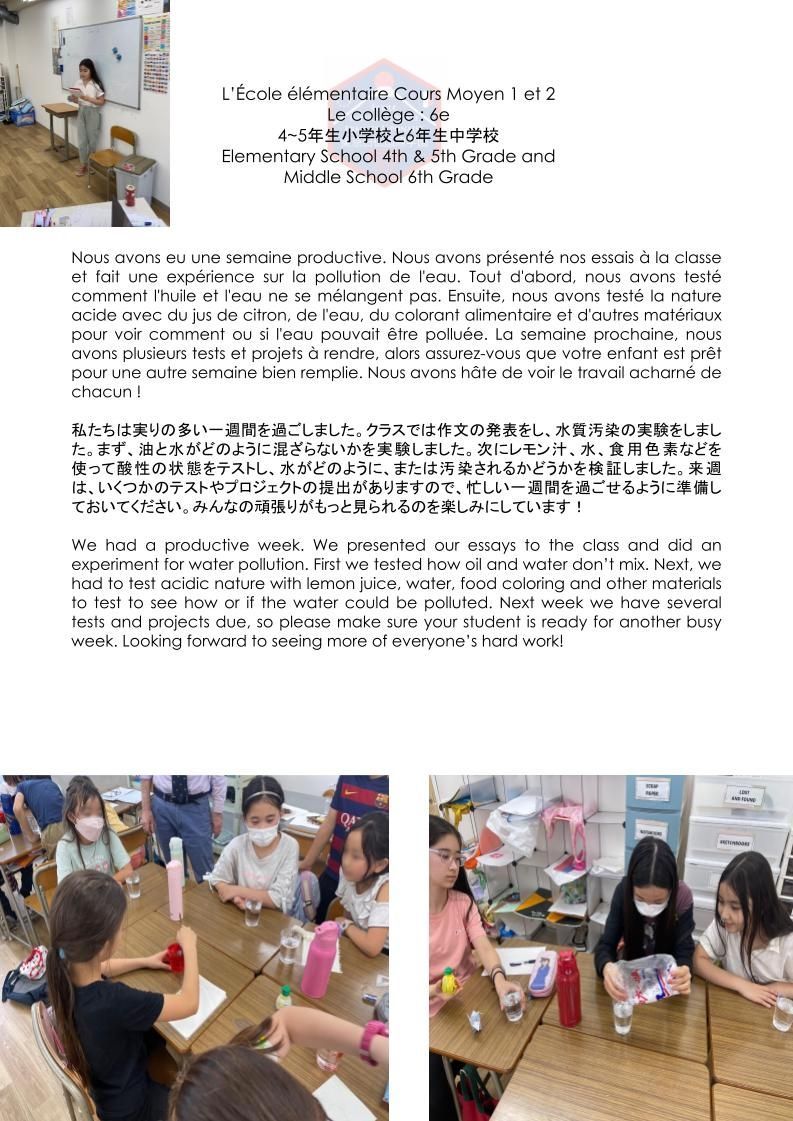
Scorecards・Weekly Learning Book・Personalized follow-up
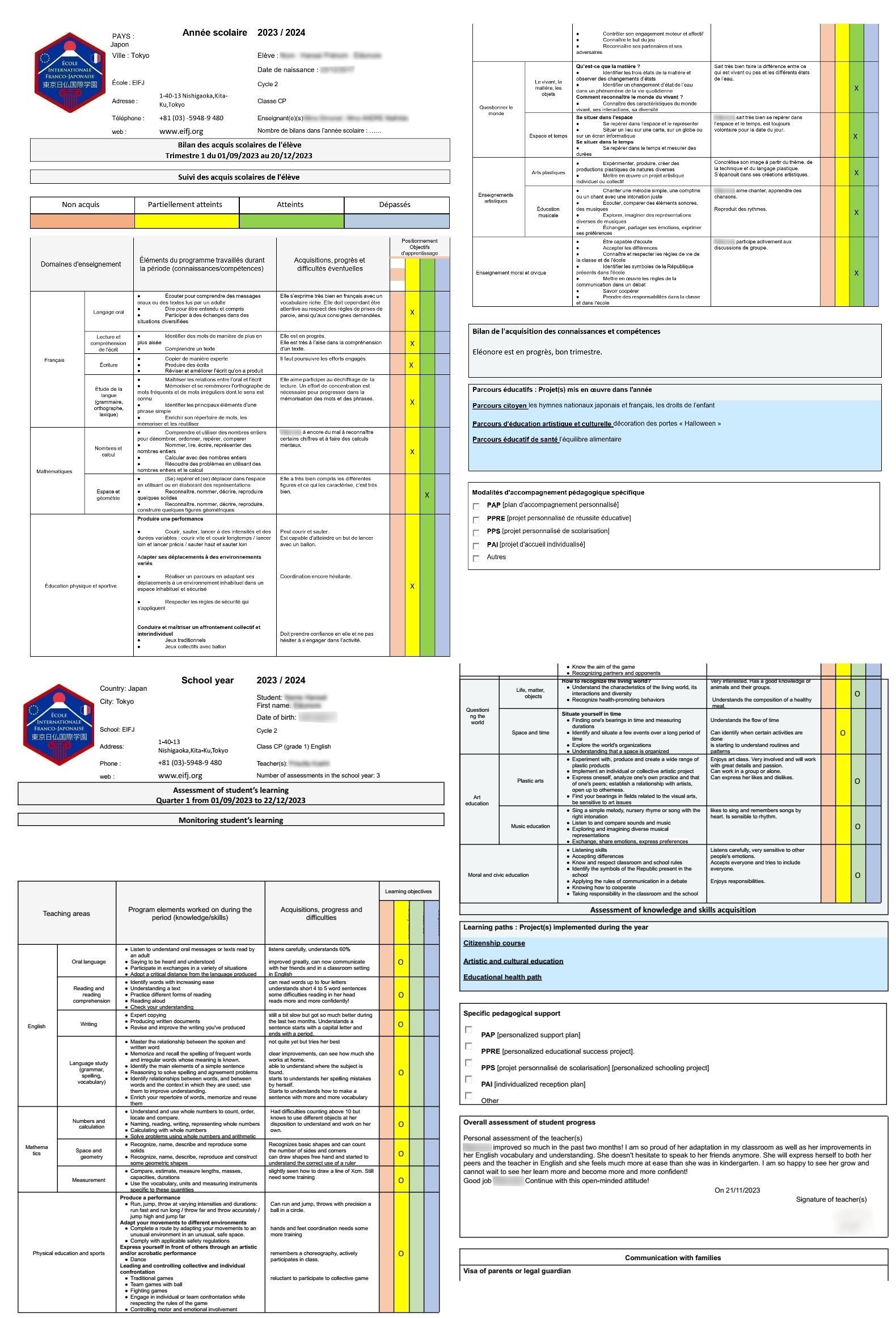

Albums de chaque année scolaire offerts à tous les élèves, 50 pages de souvenirs !
毎年度全生徒に贈られるアルバムは、50ページの思い出!
Yearbooks each year offered to all students, 50 pages of memories!

Photos, trilingual French-Japanese-English messages, reports & comments posted on Seesaw, the parents' application used at EIFJ
OPEN SCHOOL
Whether you are already a parent at the school or considering EIFJ Tokyo for your child’s education or for participating in our activities, our team warmly welcomes you and opens the doors of the school. Discover our educational activities, let your child share time with our students, ask your questions, and take advantage of the “intermittent class” program, which allows your child to experience one or more days immersed in our nursery, kindergarten, elementary, or middle school classes. Visits are possible Monday to Friday from 10:00 to 12:00 (during study periods) and from 16:00, as well as on Saturdays. Please contact us to arrange an appointment.
In addition, the Parents’ Association is also available by appointment. Families interested in enrollment or wishing to obtain further information may contact the Parents' Association's Board by email at: association.parents@eifj.org.
Elementary School - The Fundamental Learning Cycle (cycle 2)
Cycle 2 is the first stage of compulsory schooling for all pupils, beginning in Cours Préparatoire (age 6-7) and finishing in Cours Elémentaire 2 (age 8-9). It gives students solid groundwork in subjects like reading, writing, problem solving and the French language. Subjects covered in Cycle 2 include French, Modern Languages (foreign or regional), Art and Music, Physical and Sport education, Civic and Moral Education, Investigating the world, and Mathematics.
Cycle 2 is the first stage of compulsory schooling for all pupils. Language skills are the priority in this cycle, in particular French (and English & Japanese), the core subject. These three years, from "Cours Préparatoire" (age 6-7) to the end of "Cours Elémentaire 2" (age 8-9) offer an adequate, consistent length of time to give all pupils solid basic skills in reading and writing, adapted to each child's pace of learning.
In Cycle 2, pupils gradually acquire the knowledge, approaches and academic language they need to explore the world: such as solving a problem, understanding a document, writing a text, creating or designing an object. Pupils also learn gradually not just how to do an activity, but how to explain why they have done it in that way and to justify their answers and approaches in a reasoned manner. The learning process continually combines practical skills (observation, manipulation, experimentation, real-life activities) with abstract skills, through activities that help to memorise approaches and basic knowledge and make them automatic, and comprehension activities gradually leading to more complex knowledge.
French & English, French & Japanese
Learning to read and write is crucial in Cycle 2, continuing on from nursery school where pupils develop their oral expression, acquire vocabulary, discover the alphabet, practice the early stages of writing, listen to texts and learn how to understand them. French (and Japanese & English) is fundamental as it helps pupils to communicate and socialise with each other, making it easier to access all the other subjects and the language they use; for this reason there are several daily French & other languages sessions throughout Cycle 2.
The main points covered are as follows:
Comprehension and oral expression
Oral learning is essential when beginning to read and write; likewise, throughout the cycle, gradual proficiency in reading and writing leads to more varied and better structured oral expression.
Pupils read aloud and recite varied texts and complete activities that improve their understanding of the texts studied in class. Memorising texts (poems, extracts from plays that they act out, etc.) particularly helps to enrich their vocabulary and sentence structure.
They learn to be attentive when listening to or discussing with others for longer periods of time, expressing their lack of comprehension if necessary. Pupils also learn to play an active role in conversations and express themselves clearly, taking account of the discussion topic and the speakers, making relevant contributions to a discussion (asking questions, answering a question, expressing agreement or disagreement, adding extra information, etc.).
They practise recounting, describing and explaining, and in particular must be capable of recounting on their own a text studied in class.
Reading
Pupils learn to read through systematic activities that help them to master the relationships between letters or groups of letters and sounds, and to memorise words. The objective is to be able to automatically identify common words, memorise their spelling and easily decode unknown words; writing activities help with acquiring these automatic habits and learning to read.
This work is always carried out in connection with working on the meaning and understanding of texts, the purpose of all reading. Pupils acquire initial independence in reading varied texts, adapted to their age. They study five to ten works per academic year, taken from children's literature and classic literature (picture books, novels, stories, fables, poems, plays), learning how to identify genres, series and authors. Independent reading is encouraged: pupils regularly borrow books that suit their preferences and tastes and are encouraged to talk about their personal reading in class.
Reading out loud has an important role in Cycle 2, helping pupils to become familiar with the construction of written sentences. Practising reading fluency also helps to make the process of identifying words automatic; by the end of CE2, all pupils must be able, after preparation, to read a half-page text out loud fluently.
Writing
Pupils learned to write by hand and on the keyboard in the last year of nursery school; in Cycle 2, they complete their learning of handwriting, moving gradually towards automatically forming letters and increasing in speed and assurance. They learn how to do simple word processing functions and how to use a keyboard. They learn to copy or transcribe a text of a dozen lines without making mistakes, in legible handwriting, with correct punctuation and spelling, and careful presentation.
Pupils also learn to write their own texts: a sentence in response to a question, asking a question, and gradually a portion of a text or a whole text of around half a page, in coherent, organised, well punctuated language. They gradually learn to reread their own texts to improve them and check spelling.
Understanding of language (grammar, spelling, vocabulary)
The study of language in Cycle 2 is closely linked to learning to read and write, contributing to a better understanding of sentences, texts and correct spelling. At this stage of education, it is not necessary to have a complete knowledge of how the French language works as a system. It is more about observing language, manipulating it, classifying items in order to identify the main regularities and then applying them orally and in writing. Irregularities or exceptions are learned and memorised if frequently used. Pupils learn to spell the most common words and to use their reasoning to make agreements in the nominal group and between the verb and subject. They use their knowledge of language to improve their oral expression, understanding of words and texts, and improve the texts they write.
The fundamental concepts introduced in Cycle 2 help pupils to start Cycle 3 with a more systematic, conceptual understanding of the French language.
Artistic education
In Cycle 2, artistic education allows pupils to explore two areas: art and imagery, and music, taking into account the sounds and images that are part of pupils' daily environment, in order to train their eyes and ears, develop their awareness and creativity, stimulate their curiosity and give them the enjoyment of creating or discovering. Artistic or musical expression is always linked to the exploration of major works of art and artistic approaches and comparing them, not in order to imitate them, but to enrich pupils' imagination and establish initial cultural landmarks.
In Art , during Cycle 2, pupils seek personal, original responses to the situations proposed by the teacher, in varied artistic fields (drawing, painting, collage, modelling, sculpture, assembling, photography, video, digital creation, etc.) discovering new tools and materials and trying out new activities. They gradually learn to take other people into account, cooperating with them on group projects, presenting their work to them and showing an interest in their classmates' work. They learn to be spectators by observing and expressing what they experience when looking at works or productions other than their own. Three main topics, similar to the concerns pupils have at this age, are covered in the curriculum: representing the world, expressing emotions, narrating and telling stories through images.
In Music , pupils take part in group performances or productions, using their voices and bodies. They learn to sing simple melodies, nursery rhymes, singing by imitation, with expression and the right intonation, respecting musical phrasing. They create and put together sounds using various instruments or sound objects. They learn to compare sound elements and musical works by identifying resemblances and differences, expressing their emotions, feelings and preferences, and listening and respecting the work and opinions of others.
Physical and sports education
The main objectives of Physical and sports education are the same throughout the three cycles of primary school and lower secondary school, with levels of learning that increase through the cycles:
- developing motor skills and learning to express yourself using your body;
- developing motor skills and learning to express yourself using your body;
- becoming familiar with working tools and methods by practising sport;
- sharing rules and taking on roles and responsibilities within a team;
- learning how to look after your health through regular physical activity;
- becoming familiar with a physical and artistic sport culture.
Following increasing levels of difficulty, pupils gradually learn to produce their best performance, adapt their movements to varied environments, express themselves in front of others through artistic or acrobatic activities, lead and manage a match in a team or between two players. Depending on their pupils, teachers freely choose the available materials and equipment and different physical and sports activities for the lessons (athletics, swimming, dance, circus arts, gymnastics, team ball games, racket sports, etc.), constructing an appropriate, coherent training programme. They ensure that each pupil participates in a variety of individual and group activities during the cycle.
Between the ages of six and nine, in Cycle 2, most pupils spontaneously enjoy taking part in physical activity. Physical and sports education takes advantage of this enjoyment to develop and improve their motor skills, in different situations and by means of varied activities, as acquiring motor skills is essential to their future physical education and more generally their health and well-being. Particular focus is placed on learning to swim. Through individual and above all group activities, pupils in Cycle 2 also learn to follow common rules, respect their classmates and respect their own bodies, becoming aware of their abilities, limits and the potential risks to them or their classmates in certain situations. Throughout the cycle, via group activities (particularly ball games), they learn to take on different positions and roles (attack, defence, player, referee) and adapt to new situations. Through artistic activities such as dance, they discover and use the expressive resources of the body, constructing a body language and learning to verbalise the emotions they feel and the actions they perform; initially through simple execution, then by gradually composing and producing choreography, and exercising their imagination and creativity.
Civic and moral education
Civic and moral education has four main objectives during the three cycles of primary and lower secondary school:
emotional awareness education, to learn to identify feelings and emotions, put them into words, discuss them and understand other people's feelings and emotions;
- emotional awareness education, to learn to identify feelings and emotions, put them into words, discuss them and understand other people's feelings and emotions;
- education in rules and law, to understand the meaning of rules in the classroom, primary or secondary school and to make pupils (future citizens) aware of the role and importance of law in the French Republic;
- education in moral judgement, in order to understand and discuss the moral choices encountered in life, requiring pupils to put forward arguments, debate and justify their choices;
- experience of engagement, to encourage pupils to participate in the social life of the class and the school they belong to, acquire a spirit of cooperation and a sense of responsibility towards others.
In Cycle 2, one hour per week is spent on this subject. This is not theoretical education, but practical, concrete education that puts pupils in role play situations to get them to think, express themselves, act and react.
On the curriculum in Cycle 2:
- Emotional awareness: identifying emotions, expressing yourself to classmates using specific vocabulary, learning to pay attention to others (respecting adults and classmates, politeness, accepting differences); identifying the symbols of the French Republic present in the school. For example, pupils may learn to divide and share tasks in research, cooperation or experimental situations, learn about themselves and others through artistic activities (self-portraits and portraits) or become aware of their body and others' bodies through dance.
- Rules and law: respect for the rules of group living, understanding punishments, their levels of seriousness and educational value, understanding some of the values and founding principles of a democratic society, etc. For example, pupils may take part in drawing up rules for the classroom or playground.
- Moral judgement: expressing and justifying a point of view or personal choice in simple terms, taking part in a debate without imposing your point of view or rejecting your classmates' point of view, etc. For example, pupils may reflect on fairness and unfairness, good and evil by using fictional stories (tales and legends) or situations experienced by the class.
- Experience of engagement: respect for commitments made to yourself and to others, taking on responsibility in the classroom and the school, etc. For example, pupils may learn about a few major figures, men and women, involved in the scientific, humanitarian or ecological fields, or take on a role as mentors to younger classmates or mediators in disputes between classmates.
Investigating the world
In nursery school, pupils have explored and discovered the world around them in all its forms, discovering the living world, exploring materials, using, manipulating and making objects, and learning how to use digital tools. In Cycle 2, they go further, learning how to conduct an investigation and initial reasoning to describe and understand the world around them, by asking questions, observing, describing and doing experiments, and reasoning to draw conclusions.
Eight main skills are covered in this area, which are studied in more depth in the subsequent cycles: practising scientific approaches, imagining and producing, learning tools and methods, practising languages, using digital tools, adopting ethical, responsible behaviour, situating in space and time.
This subject is broken down into three main parts:
- Investigating the living world, materials and objects, to learn an initial scientific and technological approach. Pupils study matter in all its forms (living and non-living, naturally present in the environment or man-made, etc.); they observe and identify changes in the state of water (solid, liquid, gas) and relate these to meteorological phenomena (clouds, rain, hail, etc.). They learn to distinguish between living and inert beings by observing animals, plants and minerals in their environment. They observe how living beings are nourished, develop and reproduce. They observe the process of growth in their own body and the mechanism of movement. Finally, they learn about healthy living (diet, sleep, physical activity, etc.) and understand the beneficial effects on their health. Pupils discover and use technical objects in everyday life. They make objects and simple electrical circuits, learning to respect basic safety rules. They become familiar with a digital environment, in particular how to use word processing.
- Investigating space and time , to learn how to locate oneself in both space and time: pupils use common representations of space (models, plans, photos, etc.), produce their own (of the school, neighbourhood, town, etc.) and learn how to find their way in a nearby environment. In representations of the world (world maps, globes, digital maps) they learn to locate places, in particular continents, Europe, France and their own region; on maps of the solar system, they can identify the position of planet Earth. To learn how to situate themselves in time, pupils identify time divisions (months, weeks, days, hours, etc.) and their durations, and identify cyclical phenomena (the change from day to night, the seasons) using calendars, timetables and clocks. Students learn to situate events in time and in relation to others, in particular, using timelines (historical periods and characters, at the end of the cycle in CE2).
- Exploring how the world is organised , to gradually comprehend that they are part of an organised society that develops through space and over time. Pupils compare the lifestyles of different populations in the world or populations from different eras (between two generations for example). They explore nearby spaces (school, park, town, etc.) to gain a gradual understanding of how they are organised (for example the function of the different places in the town). They explore the diversity and main characteristics of landscapes (coasts, mountains, countryside, desert, etc.).
Mathematics
Following nursery school, where mathematics-related activities are based on observation and manipulation, Cycle 2 introduces pupils to the written dimension of mathematics: writing numbers, mathematical symbols, techniques for doing sums (addition, subtraction, multiplication), producing simple geometrical shapes. Problem-solving becomes central, developing pupils' ability to find out, reason and communicate their results.
Six main skills are covered in mathematics Cycle 2, which are continued in Cycles 3 and 4: discovery, modelling, representing, reasoning, calculating and communicating. Pupils gradually acquire these skills, which are part of the Common Core that will be tested at the end of compulsory education.
The Mathematics curriculum Cycle 2 covers three areas:
Numbers and calculation
Pupils reinforce and extend their knowledge of whole numbers up to 10,000, and they learn to calculate. They learn different ways of naming numbers (writing in figures, verbal names, concepts of doubling, halving, etc., units, tens and hundreds) and use these numbers to count, order and compare. They make the link between a number and a measured length. When given simple problems, they begin to add, subtract, multiply and divide. These early calculations are learned through addition and multiplication tables. Daily practice of mental arithmetic reinforces knowledge of numbers and operations.
Size and measurements
Using everyday objects and examples, pupils complete activities to learn how to differentiate different kinds of measurements (length, mass, volume, duration, price, etc.) and to compare the measurements (for example length) of two objects. They then learn to measure using appropriate instruments (hourglass for duration, graduated ruler for length, scales for mass) and learn common measurement units (mater, gram, liter, etc.). Finally, they make calculations with measurements, to solve problems in real-life situations such as finding the distance between two trees in the school playground or calculating the price of a shopping list.
Space and geometry
Pupils learn spatial recognition, in close connection with the "Investigating the world" topic and physical education and sport. This is done using landmarks and representations of space. They also acquire knowledge of geometry, by studying solid and plane shapes, learning how to recognise and name common solids (sphere, cylinder, cube, pyramid, etc.) and reproduce them. They use appropriate vocabulary to describe common geometrical shapes (square, rectangle, triangle, side, top, circle, disc, etc.) and instruments (ruler, templates, set square) to produce them on paper. They learn techniques to help them recognise that the points are aligned on a shape, that two lengths are equal, or to identify a right angle or symmetry.
Elementary School - The Consolidation Cycle (cycle 3)
Cycle 3 has two main objectives: reinforcing the base knowledge learned in Cycle 2 and helping with the transition from primary school to lower secondary school. It covers the last two years of primary school and the first year of lower secondary, in order to reinforce the continuity and consistency of learning between them. The "Sixième" class (first year of lower secondary) therefore occupies a particular place in this cycle, allowing pupils to adapt to the pace, educational organisation and lifestyle of lower secondary school while continuing on from CM1 and CM2 (Cours Moyen 1ère année, age 9-10 and Cours Moyen 2e année, age 10-11). Subjects covered in Cycle 3 include French, Modern Languages (foreign and regional), Art, Music, History of art, Physical and sport education, Civic and moral education, History and Geography, Science and Technology, and Mathematics.
During this cycle, pupils are also gradually introduced to academic subjects and their specific knowledge, language, approaches and methods, especially history and geography, science and technology. Pupils' capacity for abstract analysis increases and they begin to produce and structure their thoughts by taking in new knowledge. This introduction to academic subjects is marked during the cycle by the transition from a single teacher covering all subjects in primary school to one teacher per subject in the first year of lower secondary school.
French
Cycle 2 focused on the acquisition of reading and writing skills; in Cycle 3, the teaching of French helps to reinforce this knowledge, which is essential for all other subjects. The central objective is language proficiency, ensuring that all pupils can read and write independently so that they begin Cycle 4 with the skills they need to continue their education. This proficiency is achieved through daily writing practice and regular, numerous reading and oral activities, complemented by grammar, spelling and vocabulary activities that help them understand how the French language works and learn its rules.
During Cycle 3, the study of literary texts or artistic works takes on an increasingly important role; pupils gradually learn to identify subtext and go beyond the literal meaning to redevelop the work's figurative meaning and offer a simple interpretation.
Art
During Cycle 3, the teaching of art gradually leads pupils towards more independent artistic practice, which they also learn to analyse in greater depth. Each pupil's potential for innovation and creativity is developed. Pupils learn how to draw on their own experiences to identify, name and choose the resources they use, questioning the effectiveness of tools, materials, formats and techniques according to their intentions and their projects. Specific work is carried out on the effects produced by the various ways in which artworks are presented to the public, in order to examine the relationship of the work to a display medium (frame, plinth, etc.), a place (wall, floor, closed or open space) and the spectator. Creative activities are continually linked to the exploration of leading contemporary and past, Western and non-Western artworks, in order to nurture pupils' sensitivity and imagination, enrich their capacity for expression and form their judgement. They acquire specific vocabulary so that they can gradually move from describing a work to analysing it.
Music
The teaching of music combines expressive and creative activities, usually in a group, with listening to and analysing a variety of musical works. Its main objectives are to develop pupils' imagination, creativity and capacity for expression, train their ear, learn how to cooperate, shape their artistic culture and improve their capacity for analysis.
In musical practice, pupils reproduce works they have heard or participate in imagining and creating their own. They learn how to use their voices and bodies to sing a simple melody with expression, a song learned by heart through imitation, take full part in a group performance and gradually increase their repertoire of new songs. They also learn how to connect the music they sing to what they hear.
In music listening activities, pupils learn to describe and compare pieces of music from different contexts and identify relationships, resemblances and differences between several works. They structure their artistic culture by learning about a variety of important musical works, from all genres and all eras, suitable for their age group. They exercise critical thinking and express personal opinions by gradually going beyond first impressions and immediate emotions.
History of art
Pupils begin learning this new subject in the first year of Cycle 3 at the same time as history. From the first year of lower secondary, this subject is taught by teachers of several subjects, mainly Art and Music, French, History and Geography, and Modern Languages. Its main purpose is to structure pupils' artistic culture: they acquire and consolidate cultural references to major artworks and movements of the past and present, learning how to situate them in space and time, how to interpret them and relate them to each other, and developing their awareness of and tastes in art. This subject covers local, national and international art history, academic as well as popular or traditional; it requires contact with works of art and cultural organisations, directly and through digital resources.
In Cycle 3, pupils learn how to describe an artwork using simple and appropriate language, how to situate it in a time period and geographical area based on its main characteristics, how to express their impressions and opinions of a work and how to make an initial analysis. They also learn how to find their way around a museum or art gallery, adapt their behaviour to the place and identify the roles of the main people working there. They are aware of the influence of past and present art on their environment.
Physical and sport education
The main objectives of Physical and sport education are the same throughout the three cycles of primary school and lower secondary school, with levels of learning that increase through the cycles:
- developing motor skills and learning to express yourself using your body;
- becoming familiar with working tools and methods by practising sport;
- sharing rules and taking on roles and responsibilities within a team;
- learning how to look after your health through regular physical activity;
- becoming familiar with a physical and artistic sport culture.
Following increasing levels of difficulty, pupils gradually learn to produce their best performance, adapt their movements to varied environments, express themselves in front of others through artistic or acrobatic activities, lead and manage a match in a team or between two players. Depending on their pupils, teachers freely choose the available materials and equipment and different physical and sports activities for the lessons (athletics, swimming, dance, circus arts, gymnastics, team ball games, racket sports, etc.), constructing an appropriate, coherent training programme. They ensure that each pupil participates in a variety of individual and group activities during the cycle.
During Cycle 3, pupils exercise and reinforce their motor skills in more challenging, diverse contexts. They learn to identify and analyse the immediate effects of their actions to perfect them and improve performance, which involves both oral and written work. In team sports and activities, they continue to learn various roles (referee, observer, etc.) and understand the need for rules. Through significant practice time, pupils test and develop the working methods specific to the subject, via action, imitation, observation and cooperation. As in Cycle 2, learning to swim remains a priority.
Civic and moral education
Civic and moral education has four main objectives during the three cycles of primary and lower secondary school:
- emotional awareness education, to learn to identify feelings and emotions, put them into words, discuss them and understand other people's feelings and emotions;
- education in rules and law, to understand the meaning of rules in the classroom, primary or secondary school and to make pupils (future citizens) aware of the role and importance of law in the French Republic;
- education in moral judgement, in order to understand and discuss the moral choices encountered in life, requiring pupils to put forward arguments, debate and justify their choices;
- experiencing engagement, encouraging pupils to participate in the social life of their class and school, acquire a spirit of cooperation and a sense of responsibility towards others.
In Cycle 3, this subject is allocated one hour every week. In the first year of lower secondary, it is delivered by voluntary teachers of various subjects. This is not theoretical education, but practical, concrete education that puts pupils in role play situations to get them to think, express themselves, act and react.
History
The objective in Cycle 3 is not for pupils to gain an exhaustive knowledge of History, which is premature at this level, but rather to lay the foundations of the initial historical landmarks, which will be consolidated and extended in Cycle 4. These landmarks help pupils to understand that today's world and contemporary society are the descendants of long processes, changes and choices made by men and women in the past.
Pupils observe the concrete traces of history (particularly in their nearby, everyday environment) and question their meaning; they are gradually introduced to other types of sources and other evidence, relating to worlds farther away in time and space. They understand that the narrative of history is constantly nourished and altered by new archaeological and scientific discoveries, giving a new, different understanding of the past.
By examining historical events, pupils learn to distinguish history from fiction and understand that the past is a source of investigation. In particular, pupils have the opportunity to compare historical facts and beliefs: the study of religious events systematically roots these events in their cultural and geopolitical contexts.
In CM1 and CM2, they discover key moments in the history of France in chronological order, from the traces of early occupation of the French territory up to the construction of the European Union. Following this introduction, in the first year of lower secondary, pupils look more closely at questions and approaches specific to historical science, by studying prehistory and Antiquity.
Geography
The geography curriculum in Cycle 3 is organised around the concept of "living": the ways that humans organise and use their living spaces, on all scales. This concept enables pupils to identify and grasp the objective and methods of learning geography. Using very practical case studies (work, consumption, leisure, etc.), pupils are introduced to geographical reasoning by discovering, analysing and understanding the dynamics between individuals and societies and the land and places that they use, design and organise.
Firstly, pupils discover and explore every day, local living environments. They then examine other scales and other social and cultural environments; finally, in the last year of the cycle, they analyse the diversity of "living" environments across the world.
The topics on the curriculum encourage reflection on the challenges and necessity of sustainable development in territories.
Science and Technology
During Cycle 2, pupils "explored" the natural world by observing, questioning and carrying out basic experiments. In Cycle 3, in "Science and Technology", they begin to make an initial rational, coherent representation of this world, by tackling genuine scientific concepts. They also acquire skills and knowledge linked to the world of technology. The "Science and Technology" subject in Cycle 3 will later be sub-divided into three separate subjects (Cycle 4 at lower secondary school): Physics-Chemistry, Life and Earth Sciences, and Technology.
In Cycle 3, pupils are introduced to scientific approaches with support and help from the teacher, in a practical manner: by formulating questions, exploring research areas, then offering explanatory hypotheses, testing them through experiments, observations or simulations, and communicating their results and conclusions. They develop their curiosity, manual skills, precision in using language and rigorous reasoning, and gradually learn to differentiate scientifically validated facts from opinions.
In terms of technology, pupils explore the technical world, in particular through the history of the development of objects, designing and producing models or prototypes. They improve their skills in using digital tools.
Mathematics
During Cycle 3, pupils will reinforce the techniques they have previously studied such as mental calculation and written calculation techniques, until they become automatic (addition, subtraction and multiplication) and they will also learn new ones (division).
They discover new mathematical concepts: decimal numbers, proportionality, new measurements (area, volume, angles, etc.). In geometry, they manipulate concrete objects and discover new ways to represent space (templates, perspectives, front, side and top views, etc.). For working on numbers, and in geometry, digital tools - in particular, software - are used in addition to "paper and pencil" activities.
Finally, in Cycle 3, pupils begin a new form of mathematical exercise: problem solving. They discover that the mathematical skills and concepts they have learned are tools that will help them to solve mathematical problems. Examples of problems are taken from other subjects and from everyday life, and pupils are encouraged to find problems themselves.
*Ecole Internationale Franco-Japonaise is a candidate school** for the PYP. This school is pursuing authorization as an IB World School. IB World Schools share a common philosophy- a commitment to high-quality, challenging, international education- that we believe is important for our students.
**Only schools authorized by the IB Organization can offer any of its four academic programmes: the Primary Years Programme (PYP), the Middle Years Programme (MYP), the Diploma Programme (DP), or the Career-related Programme (CP). Candidate status gives no guarantee that authorization will be granted. For further information about the IB and its programmes visit
http://www.ibo.org.



